AV LIGHTING SOUND REINFORCEMENT RECORDING STAGE SOUND BROADCAST March–April 2023

GBI KA PIK
GUIDE TO HEARING LOOPS DISCHARGE LAMPS
ASIIS returns to west Jakarta Singapore: MICA (P) 031/05/2022 PPS 1644/05/2013(022954)

THE PLATFORM WITH THE AMPLIFIER ON BOARD.
Unica is the next-generation cloud based amplifier platform designed to provide a safe and consistent user experience for any size application, whatever your installation requirements and efficiency goals might be.
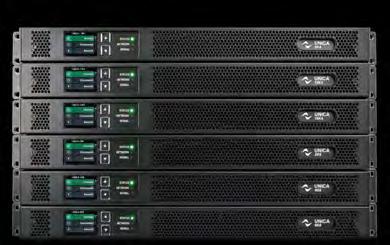
THE PLATFORM WITH THE AMPLIFIER ON BOARD. DANTE EMBEDDED MORE INFO
Unica cloud based amplifier platform. Unlock the power of consistency.
WHAT’S NEXT FOR STAGE MONITORING?
Evolving with you.
Not all wireless is created equal. Audio professionals can encounter challenges using traditional RF technology, but with Evolution Wireless Digital, fundamental limitations of wireless systems are resolved using new technology that is nothing short of groundbreaking. With the EW-DX line, there will be even more professional features for nearly any budget or application.
Discover why EW-DX is the future of wireless. Visit sennheiser.com/ew-dx to learn more about the latest members in the Evolution Wireless Digital series.
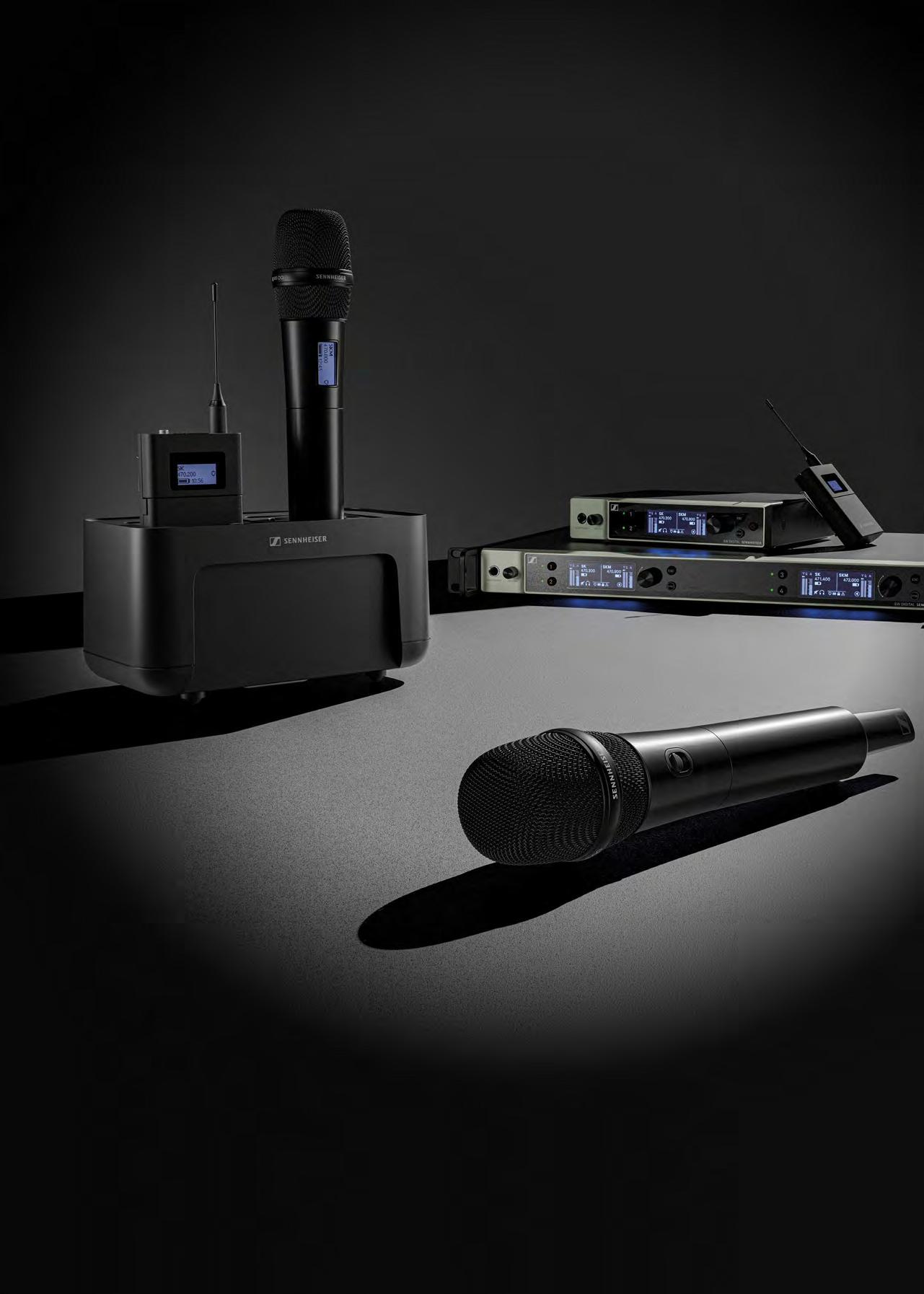 The Evolution Wireless Digital Series
The Evolution Wireless Digital Series
We’re so blessed in each issue to bring you insight from our panel of industry experts. In this edition, Azizi Ala considers how developments in technology are allowing mosques to provide more advanced visual systems (p.4), while Robert Soo continues his series entitled “Let’s do it better!” with tips on how to elevate church AV to a new level (p.6). John Black asks, What is your Why? and aims to help lighting designers make more informed decisions (p.34). In the video domain, Casey Hawkins considers the importance of buying the best equipment that your budget can afford (p.38).

overseas travels to Indonesia and Singapore. Our cover story (p.18) is from GBI KA PIK in west Jakarta which has enlisted the help of local systems integrator and distributor Acoustic Sound Image Integrated Solution (ASIIS) to create a powerful, high-impact worship experience. Meanwhile in Singapore, the Church of the Epiphany has been blessed with a new sanctuary which took over three years to construct and an Adamson IS7 line array system to powerfully reinforce services for years to come.
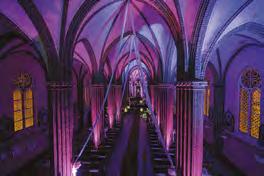




I hope you enjoy the issue.
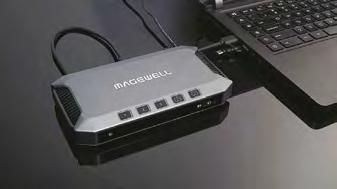
Follow us on social media @WorshipAVLMagazine





March–April 2023 WORSHIP AVL 3
All rights reserved. No part of this magazine may be reproduced or transmitted in any form or by any means, electronic or mechanical, including photocopying, recording or by any information storage and retrieval system, without prior permission in writing from the copyright owners.
LICENCES: Singapore: MICA (P) 031/05/2022 PPS 1644/05/2013(022954) CIRCULATION: circulation@worshipavl.com
Contact us Contents March–April 2023 Issue 79 Email: kwallace@worshipavl.com PUBLISHED BY: 18 Upper Grosvenor Road, Tunbridge Wells, Kent TN1 2EP, United Kingdom Tel: +44 (0) 1892 676280 Web: www.worshipavl.com Libby Stonell Digital content editor lstonell@worshipavl.com Richard Lawn General manager rlawn@worshipavl.com Caroline Moss Contributing editor cmoss@worshipavl.com Nick Smith Digital media manager nsmith@worshipavl.com Adrian Baker Production manager abaker@worshipavl.com Carolyn Valliere Sales associate cvalliere@worshipavl.com Simon Luckhurst Senior reporter sluckhurst@worshipavl.com Sue Gould Advertising director sgould@worshipavl.com Chris Yardley Video editor cyardley@worshipavl.com Marne Mittelmann Circulation manager circulation@worshipavl.com COVER: GBI KA PIK PRINTER: Times Printers Singapore COMMENT TECH FORUM PROJECTS KNOWHOW TECHNOLOGY PRODUCT SPOTLIGHT TECH VIEW 10 NorthPark Presbyterian Church 12 Little Falls Presbyterian Church 14 CHRIST University Kengeri 16 Redeemer Church 18 GBI KA PIK 22 Grace Church 24 Cathedral of Saint George 26 Church of the Epiphany 30 Hearing loops 32 Delivering the best experience 34 What is your Why? 36 What’s next for stage monitoring? 38 Cameras or lunch? 40 Light through the naked eye 4 Azizi Ala and Robert Soo 8 FOH consoles 58 Flipside AV 45 The industry’s most comprehensive product news 42 Magewell’s USB Fusion Editor’s Letter NEW PRODUCTS 6 14 22 34 36 42
Moving with the times
visual systems
OVER THE PAST 15 YEARS, THE quality produced by visual systems in mosques has improved, along with changes in visual technology, especially equipment. This technological advancement has indirectly resulted in system design evolving with more modern and practical design concepts. In this article, I will touch on the conceptual design and common technology used for the visual system in the mosque.
Concept overview
Originally, the visual system was only intended to display an image of the preacher delivering the sermon on the Mimbar during Friday prayer or during a lecture session. This is because the space in a mosque is
often quite wide, making it difficult for everyone to see the person delivering the sermon or lecture. Therefore, a camera is used to capture images of the preacher which are then distributed and displayed through a display device such as a TV. Usually, the camera is a Pan-Tilt-Zoom type and is controlled by an operator using a remote camera controller.
Nowadays, the function of the visual system has been enhanced and further expanded so that it not only shows an image of the preacher delivering the sermon but his speech is also enhanced with other images or videos for the benefit of the entire congregation. Therefore, we are seeing a more advanced system design which uses Picture & Picture
(PAP) or Picture in Picture (PIP) features so that an image of the presenter and the essence of the sermon can be displayed simultaneously on one screen using a video signal processor. In addition, these PIP and PAP features can be found and built into the AV switcher which is used to manage all video signal inputs before they are distributed and displayed through a display device. Various types of AV switchers are used to manage input video signals such as matrix switchers, scaling presentation switchers, seamless switchers and others, but all of these switchers have one thing in common in that they are capable of supporting multiformat video inputs, including legacy formats such as VGA which is still in use today via old laptops or devices.
In addition, mosques are now widely used as information points for the local community and, for this reason, an Islamic informative media device is used as a video source to display images or videos that promote forthcoming events in the mosque, such as upcoming lectures, daily prayer times, community announcements and other general events. Because of this, today’s systems are designed to operate for up to 24 hours so that this information can be displayed continuously throughout the day.
HDBaseT and AV-over-IP


Previously, the highest resolution that a visual system could offer was VGA but the main disadvantage with this system was distance. The longer the VGA cable runs, the lower the available bandwidth, which would have a significant effect on the highest possible screen resolution. Resolution has an overall effect on
video image quality where the higher the resolution, the clearer the video will be. To deal with this issue, two connectivity standards currently dominate video transmission in mosques, namely HDBaseT and AV-over-IP. HDBaseT solutions can provide lossless quality where the cable distance can reach up to 100m without any negative impact on the resolution. AV-over-IP is more flexible and expandable when switches and repeaters are used to help increase this distance to more than 100m. Both solutions are used today in the design of visual systems in mosques because now the higherresolution 4K UHD uses greater bandwidth than before.
The challenge
Cost is always going to be a challenge due to each client’s budget. In Malaysia, there is some scepticism regarding the importance of visual systems in mosques. The audio system is considered more of a priority than the visual system due to its high dependency during prayer. In other words, it is very difficult to perform prayer activities with a large congregation if the audio system fails to function or the audio is a poor quality. Due to this unpopular opinion, mosques tend to only invest in a new audio system, while the visual system is kept to a minimum by only using basic and low-resolution systems. Last but not least, many clients do not realise the fact that the ability to understand can be enhanced with the presence and help of a visual system so that the content can be heard, read, learned and easily remembered. In part 3, I’ll continue the theme of system design and look at equipment selection for visual systems in mosques. Until we meet again, take care.
4 WORSHIP AVL March–April 2023
COMMENT
Azizi Ala considers how developments in technology are allowing mosques to develop more advanced
Azizi Ala
Founder and technical director at Acousticon Sdn Bhd
Visual system using an HDBaseT solution
YOUR MESSAGE. SPIRITUAL.







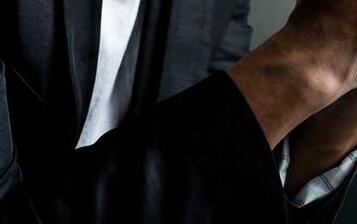















MORE THAN JUST SPEECH

It has always been our main goal to deliver clear, natural sound to ensure every word is heard throughout the whole audience. Especially in places of spiritual contemplation it is particularly important to not just transmit speech. Using K&F PIA M makes room for the most important thing: the message. Loud, crystal clear and natural.






www.kling-freitag.com























M
K&F PIA
CONVEYS YOUR MESSAGE
Let’s do it better! Miking the sound of worship
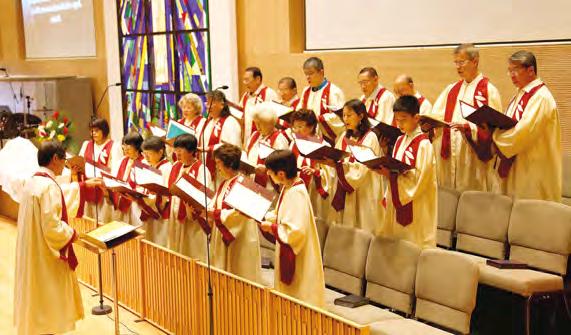
Robert Soo returns with the second part of his “Let’s do it
series, focusing on microphone fundamentals and applications
WELCOME BACK TO “LET’S DO IT better!”, a series that aims to elevate church AV to a new level of excellence. In this second edition, I’ll be touching on microphones, a seemingly mundane topic, but I believe it is the foundation to delivering a good sound to worshippers, because it always begins with properly capturing the source. So let’s dive in to some essential microphone fundamentals before addressing applications. As this is a “gargantuan” topic to expound in just 1.5 pages, I’ll touch on just the absolute must-knows for all church volunteers.
Transducer type
Dynamic and condenser microphones are basically transducers that convert acoustic energy into electrical energy, but the difference lies in their transducer types that define how and where they are used. Condensers require power from either batteries or phantom power, whereas dynamic microphones are mostly passive devices that operate without power, making them very easy to use. Perhaps the key question asked is – which works or sounds better?
Directional characteristic
An important feature is the microphone’s polar pattern, which in live sound applications will either be omnidirectional or unidirectional (with cardioid, super/hyper-cardioid variants). As their names suggest, omnidirectional microphones pick up sound from all directions, whereas the cardioid variants pick up mainly from the front axis. Both dynamic and condenser microphones can be designed to work in any of the polar patterns, with some models even providing switchable patterns. Again, the question asked will be which is better, but it is actually not about which pattern is more superior but rather which will deliver the desired outcome for the application.
Form factor
Selecting the right microphone for the job doesn’t stop at choosing a transducer type or polar pattern, as there’s the various form factors that microphones come in, such as handheld, lavalier, headworn, earworn, gooseneck, pencil condenser, large diaphragm condenser, shotgun, etc., each with its own unique design, performance characteristic and intended


sit firmly in place, so a headworn would be a more stable option. However, some ministers have reservations about donning a headworn because of its “performance look”, so choosing a low-profile, skin-coloured model that looks almost invisible from afar would be ideal.
Miking worship leaders and singers
Miking choirs
Condenser microphones, which typically have extended frequency response and reach for better clarity and details, are preferred. Often placed on stands or suspended on wires from the ceiling, unidirectional will fare better than omni in terms of gain before feedback and
and where transducer type, polar pattern and form factor come into play. Miking is usually required for the preacher, worship leader and singers, choir, acoustic piano, drums/percussions, woodwind/ string instruments, etc. Personal preferences often play a big part in microphone selection as well as in miking techniques, so let me share my approach towards miking the following.
Miking preachers
Gooseneck microphones are good when preaching only from the pulpit, although a handheld or a handsfree option like a lavalier would be a better solution. Use unidirectional lavaliers if gain before feedback becomes an issue with omnis, otherwise a headworn or an earworn with an omni element would be a safer bet. Do note that many earworns do not
ministry leaders who often have to lead with dance and hand actions. However, not everyone is keen on using headworns as they can be cumbersome, hairdo unfriendly and really challenging to dodge when you need to cough or sneeze.
It is common to use a combination of condenser and dynamic microphones on drums and percussion kits, as different microphone models are designed to suit different instruments, for example a kick drum mic, and condensers are also preferred on instruments such as cymbals, hi-hat and bells because
6 WORSHIP AVL March–April 2023
COMMENT
better!”
Microphone polar patterns
Miking a choir
of their extended frequency response. Unidirectional microphones are typically used for better channel separation.








Miking congregation
Congregational miking is a relatively
• Avoid combining systems from different manufacturers when operating under one roof. Use the same make and series of wireless systems when working with multiple channels to better manage operating frequencies and prevent potential

Work within the specified distance unobstructed with a clear line of sight to the respective transmitters. Unless remote antenna systems are used, putting receivers in a room, behind walls or in AV racks is a really bad idea. Another thing to avoid is

Use good-quality alkaline batteries.
batteries, always use high-capacity types and ensure there is a good battery maintenance routine in place.


Lastly, does paying more for higherquality microphones really make a difference? Well, like every other product, you get what you pay for and, in the case of microphones, you get better performance in the following areas: sound quality, consistent and predictable pattern, stability and reliability (especially for wireless systems) and longevity.
Well, I hope this short article has been helpful for you. There’s so much more that I would like to share, so do look out for my next article. Till then, take care and God Bless.
March–April 2023 WORSHIP AVL 7 Transmitters... ...for every purpose USA 1-800-821-1121 In Canada, call 877-753-2876 In Europe, call +33 (0) 78558 3735 In South America, call +57 310799 4564
COMMENT
Miking a grand piano with directional condensers
Bad placement and combination of wireless receivers
Which desk is right for you?
Trey Smith, Nashville Life, USA:
“Our DiGiCo Quantum225 is handling the church’s entire audio workload, from FOH to monitors. It handles it all and is still simple for anyone to operate. We have various instrument and vocal preset channels for whatever is needed each week. For those of us with experience in touring, we’re already familiar with DiGiCo, and, if not, it’s such an intuitive, logically laid out console to learn. I was able to set the console up so virtually any user could walk up and start mixing – it’s that easy. I’m using it for group processing, as well as applying it to instruments like drums, bass and vocal mics, using Mustard’s unique compression and EQ to give them their own sound and colour. DiGiCo consoles are very transparent, so when you apply the Mustard processing, you can really hear what’s happening.”
Troy B Morgan, Church of Latter-day Saints, USA:
“We were getting ready to update some of our I/O systems and, because we already had four SSL Live desks, it was a natural thing to get two more. We were familiar with them, plus they have lots of I/O power, and they have flexibility that doesn’t end. “The count can get pretty high, typically requiring
64–80+ microphone inputs. And there are always soloists and a piano, or even two pianos. The previous I/O system, which was at least 15 years old, was beginning to wear. We were spending a lot
Ed Helliwell, Rivers Church, South Africa:
“Due to the large scale of our operation, we often have to rely on the generosity of volunteers
with both internal and external effects. We had already heard about Allen & Heath’s dLive series consoles through another church as they raved about how great these consoles were and how easily even volunteers could get to grips with it. After further consulting with other users of the dLive, it was clear this would fit us best and give us the ability to grow with the system as our ministry continues to grow. This has been the best live mixing console I’ve ever used. Quick and easy to set up and the onboard effects and preamps are out of this world.”

Joey Burdette, Cornerstone Church, USA:
for both live and broadcast. When it came time to update it, the Live desks helped us solidify things and make everything much more user-friendly. Having MADI control and the interface between the consoles meant we could mount the SSL stageboxes where the previous I/O was without having to run extra copper, as now it’s a fibre line to front of house and a fibre line to the monitor mix position. And we also now have all the microphone inputs at our disposal at both front of house and monitors, without having to do any extra patching or having to get rid of a tympani mic or something.”
equipment. Thanks to Yamaha’s intuitive and standardised console design across generations, these volunteers can easily slot in and very quickly feel at home on the interface, even on a console they’ve never seen before.”

Corey Wilson, Christ Church, USA:
“We’ve been growing so quickly and our tech requirements had really increased. I was definitely feeling the pressure to move forward with a more powerful console. Not only a desk with more channels, but with the versatility to send out multiple feeds for broadcast and work well
“The flexibility, workflow, reliability and expandability of our Lawo mc²56 are things no other console offers. And the audio quality is beyond anything else on the market. Our operators love how user-friendly it is and how fast it is to work on; the console adapts to their workflows instead of the other way around. Because the A__UHD Core can be a pooled resource for up to four consoles, we can easily expand our capabilities just by adding additional surfaces and stageboxes around the campus. Connecting everything with an IP network makes growing the system very easy. We’re already looking to add more Lawo audio consoles to our facilities.”
8 WORSHIP AVL March–April 2023 TECH FORUM
A front of house console is an integral part of many house of worship audio setups – here we explore the benefits some of the most popular choices can bring
TECH FORUM
DiGiCo’s Quantum225
The CL5 digital mixing console from Yamaha
Use Freely and Cleverly
ACT-5800 Series Digital Wireless Systems




MIPRO ACT-5800 Series digital wireless systems operate in ISM 5.8 GHz license-free band so they can be used freely in any country. No ma�er presenta�ons, conferences, lectures, choirs or ensembles, ACT-5800 Series can fulfill your cable-free sound pick-up or recording requirements by offering various kinds of transmi�ers and microphones.


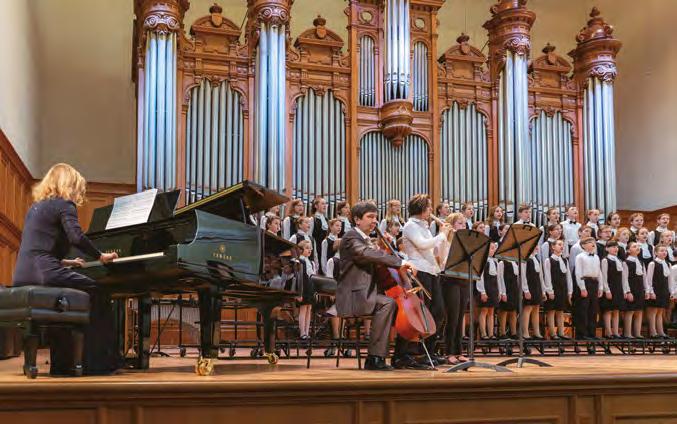


www.mipro.com.tw







100% Mad e i n Taiwan

Staying connected
CLAIMING THE ACCOLADE OF
the first Presbyterian church and the second-ever house of worship built in Dallas, Texas, NorthPark Presbyterian Church has an in-person membership of more than 350 worshippers who travel from the suburbs of Dallas and beyond. Faced with the challenges of a pandemic, communications manager Martica Luckey and AV manager Stuart McRae turned to livestreaming to not only keep the dispersed congregation connected but also to grow it beyond the Dallas area.

Having previously used an ATEM Television Studio Pro HD live production switcher, the upgrade to the ATEM SDI Extreme ISO allowed Luckey and McRae to streamline their setup while creating a broadcastquality stream. A HyperDeck Studio HD Mini broadcast deck is also used for backup recording.
“I have been managing our sound system on Sundays and recording the sermons for over 12 years,” declares McRae. “Admittedly, we felt we were behind the times with our social media but all we had were plans to update our website. When the pandemic caused us to close our church, we created our Sunday service by recording segments, editing and then posting the service to play each Sunday on YouTube and our website. Over the course of the next year, we learned how much time it takes to produce one hour as opposed to streaming it live. As we reopened our church, a lot of people were afraid
to come back, so we knew that we needed to stream, even though we had a small staff to achieve this.”
“We used to have SDI-to-HDMI converters on our cameras and video feeds but standardising on SDI gives us so much more dependability and reliability, along with eliminating several potential points of failure. Plus, we don’t need to spend money on converters,” Luckey explains. “Not to mention the ATEM SDI’s built-in streaming capability. It gives us more technology in a smaller footprint.”
“We use 7–10 microphones in our services, mixing on a separate console, and send a dedicated output with no EQ to the line level inputs on the ATEM,” adds McRae. “While we don’t amplify our choir or organ in the sanctuary, we need to have both on the stream in stereo. We also make a point to capture the spoken congregational responses and singing hymns. We always want to have sound on the stream and not the audio equivalent of a fade to black. With live sound, we only use compression to hold levels consistent, but this would give us too much level fluctuation for the stream. With the ATEM’s Fairlight audio mixer, we use the expansion and compression to control our apparent loudness to standard listening levels. Taking a flat feed, we can also adjust the equalisation with the Fairlight audio engine.

“All four of the assignable SDI outputs are used. We send our
Program out to the DeckLink Duo card for encoding and streaming. A second output is used for our multiview monitor. The third goes to the HyperDeck Studio HD Mini and the fourth is our programme confidence monitor. During our streams, we use our NorthPark logo in the top right corner using the Upstream Key. We use the Downstream Key to incorporate our presentation software text for songs and verse in the lower third.”
Luckey also benefits from the ATEM SDI Extreme ISO’s ability to save a DaVinci Resolve project file – with a single click, she can open the live production as a video edit. “Being able to record all of our cameras, as well as our video presentation software output, with the ISO feature onto a simple hard drive couldn’t make backup any easier,” she notes. “When we record any services in advance, we’ll be running this so that if we have any switching mistakes, we
can rectify them in DaVinci Resolve. We use two PTZ cameras with plans for a third. The camera wires are long but, since they are SDI, connecting directly to the ATEM SDI Extreme ISO gives us the best quality possible.” Looking to the future, Luckey and McRae plan to expand beyond the church’s sanctuary. “We need to send video to several TVs around the building, including one just outside the sanctuary on a legacy video network. We’ll be sending the output from the ATEM SDI Extreme ISO to an ATEM Streaming Bridge to feed those TVs with minimum video delay,” McRae concludes. “We are now also using the streaming workflow for funerals, award ceremonies and other initiatives within the local community. Blackmagic Design has helped us grow our technical workflow, better connect with the local community and reach a global one.”
www.blackmagicdesign.com
10 WORSHIP AVL March–April 2023
PROJECTS
NorthPark Presbyterian Church is using an ATEM SDI Extreme ISO live production switcher to expand its digital presence across the US, Canada, South America, Asia and Africa
ON YOUR MARKDATA - GO!
Modular system for customized infrastructure solutions

Wide range of modules for fully networked media technology concepts


Classified cable-bulkware according to EU Construction Products regulation (EU CPR)
Ready made Network and Fiber Optic Systems for mobile and installation applications


High-quality, certified connection components







SOMMER CABLE based in Straubenhardt/Germany was founded in 1999 and is now one of the leading suppliers of professional high-quality cable and connection technology with a focus on the audio, video, broadcast, studio and media technology sectors. The product range including the in-house brands HICON, CARDINAL DVM and SYSBOXX covers cable bulkware, connectors, connection cables, individually adaptable distribution systems and electronics.
REQUEST INSTALLATION CATALOG FOR FREE ! NEW 2023
A B2B shop with over 25,000 products is available 24/7. www.sommercable.com

 31.1 - 3.2.2023 Barcelona - ES Fira Barcelona Gran Via Booth 5E400
Professional Studio Event Technology
Signal transmission hardware (HDMI®, HDBaseT, etc.)
Bulk cables according to EU CPR, RoHS
31.1 - 3.2.2023 Barcelona - ES Fira Barcelona Gran Via Booth 5E400
Professional Studio Event Technology
Signal transmission hardware (HDMI®, HDBaseT, etc.)
Bulk cables according to EU CPR, RoHS
• info@sommercable.com
Worshipping live
system to move its
ESTABLISHED IN THE EARLY 1950s as a small chapel holding around 100 parishioners, Little Falls Presbyterian Church, located in Arlington, Virginia, has expanded over the years to a campus that seats 300–350 congregants. Pre-pandemic, the church offered both a traditional service with a pipe organ and choir and a more contemporary service with a praise band.
Around eight years ago, the church modernised its sanctuary with new screens to make its contemporary service more accessible. “The

content out live. The church’s head of AV Duane Lomis, who works for Arlington County Schools, was already familiar with Broadcast Pix. Just as Little Falls Presbyterian Church was looking into sourcing separate cameras, software and video mixers, Broadcast Pix launched its ChurchPix system. “Although the system was slightly more expensive, we knew that it was going to be worth it in the long run,”
ChurchPix is an all-in-one video production solution that enables any church to stream its worship services online. The system includes two RoboPix PTZ IP cameras with 20x optical zoom, integrated remote control and mounting brackets; PC hardware and IP switch; up to three IP/NDI inputs for worship applications, PowerPoint or other sources; a royalty-free library of suitable clips, stills and graphic templates; instant streaming and recording; audio inputs that support any Windows Audio Device including NDI, Dante and external USB convertors from the house sound system; and an easy-to-use software control interface that automates common production tasks.
As the church attempts to rebuild in-person attendance back to pre-pandemic levels, the decision was made to hold just one service a week, which Robinson describes as a blended service with contemporary music mixed with more traditional hymns. “We have a lot of elderly people in our congregation, and not everyone is comfortable coming back to church,” he says. “Now that we can go live with our service it’s a huge blessing.”
projectors, 4m-wide screens and a new Tannoy audio system,” explains Todd Robinson, who has been director of worship and music at the church for 10 years.

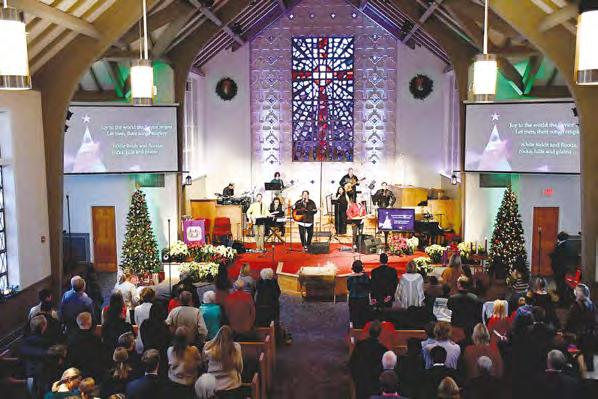
Which brings us to the start of the pandemic. “At that point, we didn’t have any video sourcing at all, we were just using audio recordings and sending them to a podcast or to iTunes for people to listen to,” continues Robinson. “So, when we decided to go virtual at the start of the pandemic, I would film the pastor or people would send me videos of themselves reading prayers or scripture that they’d made at home and I would edit it altogether and upload the content to YouTube and Facebook every Saturday evening. We did that for the entire pandemic.” The church was also able to take advantage of their outdoor chapel in a wooded
area to the side of the building for in-person worship.
After a cautious reopening as Covid restrictions were eased, Robinson soon realised that they didn’t have any way of putting
wanted to get out of the system. We practised for 2–3 weeks before the church reopened just so we could teach our volunteers how to use the new equipment. It’s made my workload so much better!”
Robinson is full of praise for the new ChurchPix system. “It’s made life so much easier for our volunteers to run a service without any complications,” he explains. “After we set everything up, I created a run sheet for audio, projection and streaming and all the volunteers need to do is follow this colour-coded sheet. If we’re doing announcements, all the volunteer has to do is click on the button that says announcements. It’s a no-brainer!”
Lomis has already invited other local church technicians over to show off the new system and see how little space it takes up and how efficient it is. It sounds like it won’t be long before other churches in Arlington cotton onto the benefits of using ChurchPix for their services.
www.broadcastpix.com
www.littlefallschurch.org
Little Falls Presbyterian Church has taken delivery of a Broadcast Pix ChurchPix
weekly services online
12 WORSHIP AVL March–April 2023
PROJECTS
One of the two RoboPix PTZ cameras
The livestreaming setup
Unlock your Soundscape.
Hearing, seeing, feeling, connected. A new listening experience. Involvement with a most beautiful intensity. The interaction between artist and audience, more intimate than ever before. Enveloping sound reinforcement, succeeding so much more than right and left.
d&b Soundscape gives designers, engineers and artists the tools to create exceptional audience experiences.
dbsoundscape.com

 Photo: Tanner VonnahmeI, unsplash
Photo: Tanner VonnahmeI, unsplash
Audio revamp
StageMix Technologies has supplied an Adamson E-Series line array system for the Kengeri campus of CHRIST University in Bangalore
THE 4,000-SEAT OPEN-AIR auditorium at CHRIST University’s Kengeri campus in Bangalore has been installed with a brand-new Adamson system. The setup features a main stereo hang of six E12 line array cabinets, supported by three E119 subwoofers flown behind the main PA system on each side for coverage of the audience area, along with six IS7px point source speakers for centre-fill, supplemented by IS219 dual 19-inch subwoofers placed under the stage, and CS10p self-powered loudspeakers for delays, all powered by Lab Gruppen D200:4L amplification.


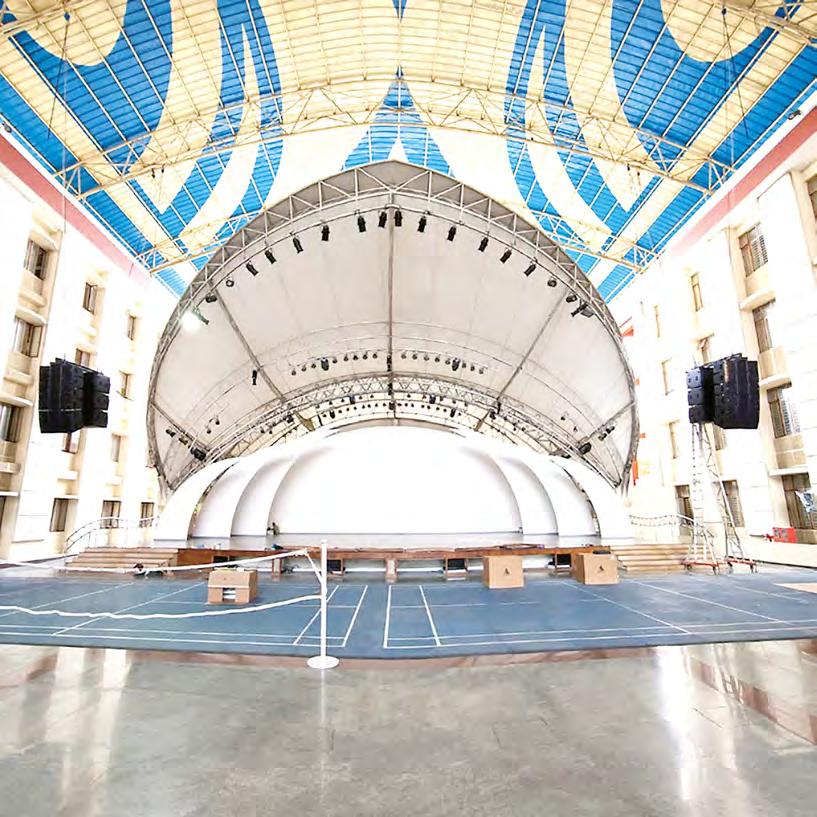
The entire system was sourced through StageMix Technologies, the authorised distributor for Adamson Systems Engineering in India, and was installed by Digiann Solutions. The Kengeri campus is one of three CHRIST Universities in Bangalore, Karnataka with the other two located in Bannerghatta and Yeshwanthpur. It also has campuses in Lavasa, near Pune, and Delhi.
Mano V Jacob of Digiann Solutions who consulted on the installation process shares: “The college management at CHRIST came to us wanting to revamp the audio system at their Kengeri campus auditorium. After considering multiple options, we finalised
on the large-format E-Series line array from Adamson. StageMix provided us with simulations using Adamson’s Blueprint software along with CAD layouts, and schematics which greatly helped us calculate the optimal speaker positions and rigging points required. The Adamson system covers the space so well and gives such a warm, smooth sound even at a higher SPL
with no harshness. The client is extremely happy with the result.”
Nitesh Narayan of StageMix adds: “One of the challenges was that the system had to be suspended from the steel truss structure of the roof, which required the weight be kept to a minimum and distribute the load between two adjacent beams. We were able to achieve this with the Adamson E12 since it is relatively
lightweight, and its rigging hardware makes it easy to adjust the angles for fast and secure deployment. The Adamson system provides consistent, clear audio right to the last seat, which is a distance of about 55m. We also added a pair of CS10p speakers as fills at the back to further enhance speech clarity for the last few rows. The CS10p has an option for MILANbased networked audio which was very useful given the long cable runs from the console to the speakers.”
“The inaugural event with the new audio system featured a performance to a crowd of over 3,000 students attending a national level festival hosted by CHRIST University,” says Rev. Fr. Jiby, director at the university. “The system performed well above our expectations, and we have received very positive feedback from the faculty and students alike.”
“It has been a great experience working with the StageMix team, as they were able to understand and cater to the exact needs of the CHRIST University management and we look forward to working with them on more projects in the future,” Jacob concludes.
www.adamsonsystems.com www.stagemix.com
14 WORSHIP AVL March–April 2023
PROJECTS
The main stereo hang consists of six E12 line array cabinets
Three E119 subwoofers are flown behind the main PA
SOUND SOLUTIONS FOR INSTALLATION HDL 26-A SYSTEM


HDL 26-A
133 dB max SPL
2000 W peak 2-way Class-D
55 ÷ 20000 Hz Frequency Range
100° x 10° coverage angle
3” Titanium Compression Driver
2 x 6” Neodymium Woofers
HDL 35-AS
Flyable complement for the HDL 26-A
134 dB max SPL
2200 W peak 2-way Class-D
40 ÷ 140 Hz Frequency Range
15” Neodymium Woofer
Networked Management
FiRPHASE Technology
Lightweight and easy to deploy, HDL 26-A Array module feature RCF transducers, Class-D amplifiers, and proprietary FiRPHASE DSP processing for a natural sound at any volume. Incredibly even SPL, consistent coverage, and flexibility for an extended market of professional installations and integrations. The complete integration of all elements provides users the freedom to adapt the system to the location, with powerful software tools for system design, tuning, and management.
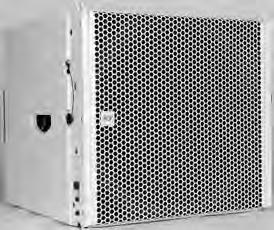
www.rcf.it
An inspired solution
supplying UK touring and musical acts with their AV needs. Last year, the company also took on the UK distribution for Inspired Audio. “We have toured Inspired Audio speakers since the company started,” explains Churchill. “We tried and bought some of their equipment and that’s how our relationship began. We like the Inspired kit and were happy to tell people about it and how it’s worked for us. And, without meaning to, we sold a few systems as well. We talk the same language as the users and can easily recommend Inspired with no reservation.”
Churchill has been a regular worshipper at Redeemer Church Nottingham since it founded. In 2017, Redeemer was planted from Cornerstone Church and moved into the Beeston Youth Community Centre, which required a new audio setup for its services. “Redeemer wanted something people could move easily and that sounded great,” continues Churchill. “The church tested several high-end sound systems and I helped with a demonstration of an Inspired Audio AX8/B210 setup. The community centre was a very reflective space so the larger speakers were bouncing around the room. Compared to one of the other speaker brands, the

However, the congregation quickly grew and, in 2018, it was clear the church would expand beyond the community centre’s capacity and a search began for an alternative venue. In early 2019, Beeston’s local council was also in the process of finding potential bidders to buy the Old Town Hall. Redeemer submitted a strong proposal and, following successful financial arrangements, purchased the premises. Since then, the building has undergone considerable renovation and modernisation, with a custom-built auditorium added to the rear of the site becoming Redeemer Church’s new home in 2022. “When they started this rather interesting project in the Old Town Hall, they asked me to come up with some ideas and I guided them in the direction of Inspired Audio again,” adds Churchill.
The original plan was to hang four Vector 20 constant curvature array boxes straight in the middle, but the church wanted a stereo image, so Churchill fitted two hangs of four Vector 20s, each covering one side of the auditorium with 110° x 80° dispersion. Each speaker has a 10-inch bass driver, two 5-inch midrange drivers and two 1-inch highfrequency ring radiators on a custom


and right of the stage. The setup is powered by two Q20 amplifiers, giving enough channels to zone the main auditorium and balcony areas. “The seats go to the far edges of the room and some of the seating is under the balcony where you’re out of range of the speakers, so we’re looking at putting in some of the Inspired 4-inch models which should resolve any dead spots,” says Churchill. “When you can see the speakers there’s no trouble but, when you’re out of speaker range, you’re counting on reflections. There’s a bar that runs round the room which I requested during the design process because I wanted a way of being able to retrofit things at a later date, so we can add the 4-inch models to this bar when they’re available.”
However, Churchill encountered several challenges along the way. “Although we’d specified to the contractor where we wanted the holes for the cables to go and where we wanted the lighting to go, nothing was in the right position when we came to install the equipment and we had to redo everything. Then, once the speakers had been fitted, we realised that the room hadn’t been
treated acoustically so we needed to add some wall and ceiling panels, mostly for absorption.”
The Precision MD also discovered very soon after installing the speakers that he would have to zone certain areas in the auditorium. “We had to zone the bottom speaker away from the two middle ones and the top one. The room naturally and acoustically fell into a couple of different spaces. A lot of the sound kept hitting the balcony so, by zoning the speakers, we could make it uniform across the whole area. There’s still a few acoustic issues on the balcony that we’re trying to get
Precision Audio Solutions’ Andi Churchill has stepped outside of his normal
16 WORSHIP AVL March–April 2023
PROJECTS
Andi Churchill
rid of, but it’s a lot better since the acoustic panelling has been added.” In terms of lighting, Churchill specified four Chauvet Professional Ovation F-265WW, two Ovation F-145WW Fresnels and three COLORdash Par-Quad 18s. “We’ve


when the band’s playing, they widen out to highlight the whole stage.”
One of the biggest challenges Churchill faced was getting the lighting bar and the lights high enough so that they wouldn’t interfere with the top speaker. “It

when someone comes up to talk, they zoom in tight to the speaker but,

high enough,” he explains. “So, we put little outriggers on the lighting
bar on the top of the truss which is what the bigger F-265WWs are hanging from. The lights are about a foot higher than we originally planned. The high frequencies in that top box would have shot out and fired straight into a metal object. The outriggers were a neat solution.” The Precision MD also plans to mount four Epson EB-L730U edge-blended 4K projectors on the lighting bar between the speakers so that the entire wall at the back will function as one big screen on which to project images.
Despite the obstacles his first church installation brought him, Churchill isn’t ruling out another. “We’re hoping houses of worship might be a market that we’ll develop into, maybe not directly but through other people in the UK church installation sector.” Only time will tell whether another Precision Audio Solutions church project will find its way into the pages of Worship AVL
www.inspired-audio.co.uk

www.precisionaudiosolutions.co.uk
TS-790 Series Conference System with Amplifier and USB Audio

The latest addition to the TOA range of Conference Systems. The TS-790 series features 2 Central Units for selection - both have a 120 W built-in amplifier for use with external speakers and one is equipped with 2 dedicated slots for Wireless Tuner Modules. The TS-790 series can connect up to 64 units and USB audio interface allows easy setup for web meetings or audio recording. It is the most convenient and compact all-in-one system.
We supply sound, not equipment.
PROJECTS March–April 2023 WORSHIP AVL 17 TOAasiapacific www.toa.com.sg
Churchill fitted two hangs of four Vector 20s
The road from Solo
RELOCATING TO THE INDONESIAN capital of Jakarta from Solo 10 years previously, worship pastor Yosie Jendrah left most of his old life behind in central Java. However, he retained valued contacts knowing one day that they would assist him in his future aspirations to serve God within the Gereja Bethel Indonesia (GBI) church. One of those contacts was his friend from systems integrator and distributor Acoustic Sound Image Integrated Solution (ASIIS), Andy Mulya Sutikno.
“Our family of worshippers come to encounter and experience the glory of God in their lives at GBI, so we stage a strong prophetic worship style,” explains Jendrah.
“During my work at GBI Solo over 10 years ago, Andy assisted us with many technical aspects of our service. The ASIIS team fully understood how we wanted to host our worship sessions and created a very powerful, high impact

worship experience. I fully valued our personal and professional relationship knowing we would meet again in the future.”
When a plot of high-value realestate was donated to GBI in the final testimony of a believer in 2012, the paths of both friends
would be inextricably reconnected. Once a licence to build was granted in 2020, Jendrah was called to the rising Keluarga Allah PIK in west Jakarta, which in turn would lead to his trusted technical expert in Solo receiving a phone call. “I have personally known ASIIS for over 10

years as they are highly respected amongst Indonesian houses of worship,” continues Jendrah. “As such, we made a request to Andy and his team to submit a tender for the audio and lighting technological fulfilment for our services.”
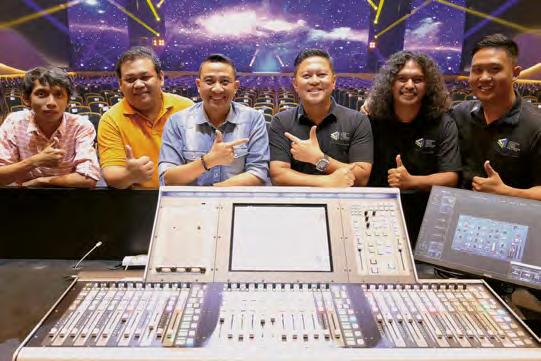
The architectural design of GBI Keluarga Allah PIK was based on the vision of the church elders. From 2020, GBI KA PIK oversaw the two-year construction of the 4,200m2 nine-level development. The interior design for GBI KA PIK was provided by Jakarta-based architect Ferdinand K of Hafe Studio. “As our services are highly charismatic, we specified a state-of-the-art loudspeaker and lighting system for our seventh-level sanctuary,” adds Jendrah. “Following a successful demonstration, we awarded the contract for integrating the sound reinforcement and lighting system to ASIIS.”
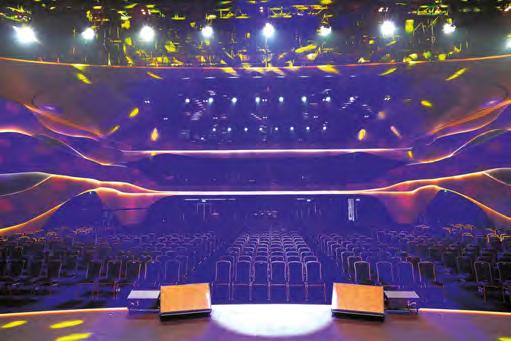
ASIIS has provided GBI KA PIK with a full live sound experience within the sanctuary as well as audio broadcasting connectivity for worshippers at home
18 WORSHIP AVL March–April 2023
PROJECTS
The six-per-side Clair Brothers C10 line array delivers even coverage throughout the sanctuary
ASIIS has empowered GBI KA PIK to stage a strong prophetic worship style
The pastor relies on a pair of NEXO P15 wedges to monitor his speech
The ASIIS team return to GBI KA PIK in west Jakarta
SPREAD THE WORD
Compact, powerful and unobtrusive, NEXO loudspeakers combine even coverage and full range sound with excellent speech intelligibility to create the perfect system for worship spaces. Find out more about spreading the word at nexo.sa.com






Thinking. Inside the box.

ASIIS was challenged to design an audio system that would provide a full live sound experience within the sanctuary in addition to providing audio broadcasting connectivity for worshippers at home. “The church required a highly dynamic, full power system for the in-person congregation, but it also needed to broadcast the high impact experience,” explains Andy. Modelling various loudspeaker models in EASE, Andy confirmed that a Clair C10 system would provide ample coverage, power and a very smooth response across the 1,600-capacity room. “The simulations also confirmed very high intelligibility from the front to the rear and from right to left,” he comments. “There was less than 3dB SPL difference across the intelligible frequencies.”
The L-R Clair Brothers C10 line array loudspeaker system comprises three C10-M-120 and three C10-M-100 modules per side. The C10 three-way modules are supplemented in the lower frequencies down to 38Hz (–3dB) with the addition of eight CS218 double 18-inch subwoofers located below the stage. Three Clair Brothers D80:4 and two D2000:4L four-channel amplifiers power the entire system. Providing 120° horizontal coverage, the three C10-M120 speakers at the bottom of the array cater for the seats towards the rear. Carefully rigged to ensure that none of their output is concentrated on the rear wall, the upper three C10-M100 cabinets exert a narrower 100° horizontal dispersion. Six P8-95 8-inch front enclosures have been positioned on the lip of the stage to cover the front row seats.
“For me, Clair is the most powerful loudspeaker in the world and the technology incorporated into the dual 10-inch C10 design makes it highly unique,” furthers Andy. “The waveguide integrates the middleand high-frequency sources together into one unit, so instead of having multiple drivers, they are placed in different areas, but are aligned. The mid and high frequencies output from the same drivers simultaneously and this combination provides excellent coherency between 300Hz and 2kHz. That’s why the C10 three-way series doesn’t sound like multiple drivers –it’s more like one full source of coherent speakers in a line.” A loudspeaker system, however, will only ever be as good as the room acoustics allow. At 4kHz
and 8kHz, the ASIIS engineers discovered that the room response simulations depicted acoustic problems and concentrated energies in the form of flutter echoes. “Fortunately, these echoes were within the church’s tolerance, without hindering the worship experience,” comments Andy. “To cure this, treatment in the form of wall absorbers and curtains will be needed at the 4kHz and 8kHz frequencies respectively.”
In terms of microphones, four channels of Shure ULX-D and six channels of Shure QLX-D wireless transmitters and receivers have been adopted by pastors/worship leaders and the singers respectively. “We tested the Shure SM57 capsules with the worship leaders and the singers and they acknowledged a desired warmth and clarity without being boomy,” explains Andy. The
musicians opted for IEMs rather than wedges, with eight Sennheiser ew IEM G4 transmitters and receivers synchronised wirelessly via infrared. “The IEMs have adopted wired preamps, allowing the monitor engineer to mix and control each musician individually.”
In addition to the main loudspeaker and monitoring systems, ASIIS custom designed the mix position for premium quality broadcasting. At the front of house mix position, a Solid State Logic Live L200 control surface receives its inputs from two SB3224 32-in/24-out stageboxes, which are automatically connected within the software routing pages. A maximum of 144 fully processed mix paths – at 96kHz – can be assigned as channels, stem groups, auxes and masters.

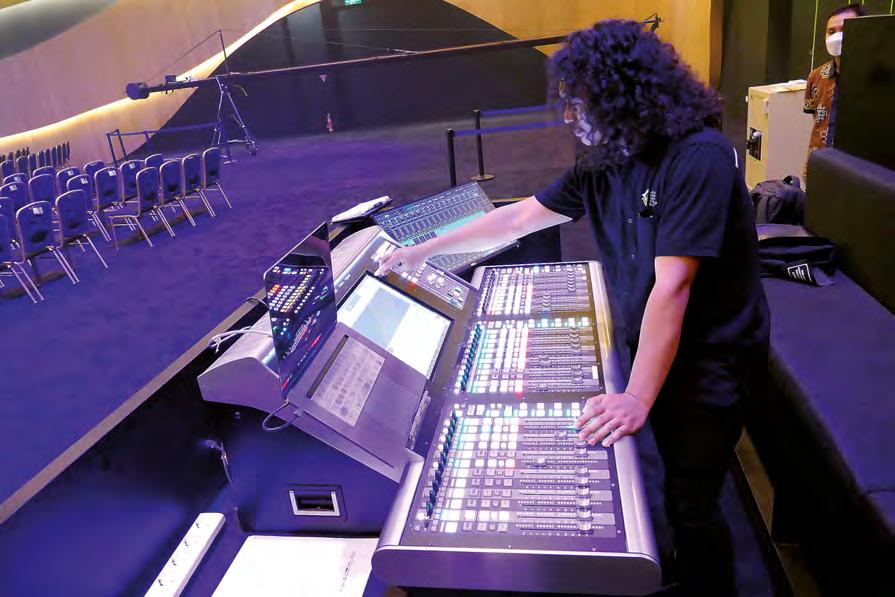
“Our church engineers love the warm SSL sound in addition to its
intuitive operation,” comments Jendrah. “The touchscreen is modelled on an analogue design with compression, gates, expanders, limiters, preamps, dynamics and faders. Additionally, there are lots of short cuts to enhance the workflow. The onboard processing with stems can easily be used for all musical genres.” From the SSL Live L200 console, Pro Tools has been added for transferring data to the Waves consoles and for any future planned recordings, including sound checks. Added plugin processing comes from a Waves SuperRack comprising an Axis One host and Extreme-C server networked via the SoundGrid Ethernet protocol. Hosted on a computer, the MultiRack plugin software supports both Native and SoundGrid processing for up to 128 audio channels with the Waves plugins directly from the L200 console. “With this extension, the FOH, monitor and broadcast engineers can run plugins in real time, customise their work with floating windows, set extendedscope snapshots and run any live show with greater ease and speed,” furthers Andy. “The Waves setup adds more colour, scenes, saturation and harmonics to the mix. The performed songs here at GBI are very complex and vary considerably, so the Waves SoundGrid adds depth.”
The microphone signals are converted, before being routed to an analogue 64-channel splitter with an optical MADI interface. “By
PROJECTS
20 WORSHIP AVL March–April 2023
ASIIS technician Ebenhaezer Christo at the control surface of the SSL Live L200 console
A Waves eMotion LV1 software-based mixer at the monitor mix position
separating the feeds, the church can transmit to the SSL Live L200 console at front of house and a Waves eMotion LV64 64-channel mixer for broadcasting,” explains Andy. “For the AVI transmission, we installed the Waves Extreme-C SoundGrid server. In addition to a MADI connection, a Dante card can be inserted in future for enhanced management and control across the IP network.”
A duplicate setup comprising a Waves eMotion LV64 64-channel mixer and Waves SuperRack has been established for monitor mixing at stage right. The microphone inputs here are fed from Waves SoundStudio 2412 24-in/12-out and 1608 16-in/eight-out sta geboxes, while the broadcast feed required a smaller-scale StageGrid 1000 eight-in/four-out stagebox.
Having successfully integrated a highly dynamic and full power audio system within budget, ASIIS was challenged to design a high-impact lighting system within the sanctuary of the Keluarga Allah PIK.
Specified on account of their reliable, consistent and price performance features, ASIIS focused the design on a selection of Chauvet Professional fixtures.

For the key lights and back lights, 17 Ovation F915 variable white fixtures with barndoors provide different colour temperatures for different kinds of surfaces. “The Chauvet solution creates very warm colours and saturations are also notable. For general surfaces, GBI prefers to use a warm colour, but they can increase the temperature when more light is required and the skin tones need to be highlighted,” explains ASIIS engineer, Tommy Hartono. In total, ASIIS installed eight Chauvet R3 Spot washes, 28 Rogue R3 Beams, six R1 BeamWashes, 10 COLORdash PAR H121Ps and 16 Ovation P-56FC fixtures, while for the house lights, a total of seven Strike Arrays 4s were added.
“The lighting technician can dip in and out very smoothly during performances and sermons,” furthers Andy at the control surface of a ChamSys MagicQ 250M.
“Loaded with scenes, cues and presets, the lighting console is very intuitive. To date, the volunteer operators at the church have confidently and easily operated the lighting system following a quick briefing. The MagicQ 250M can be quickly programmed and produce very fast light bursts. The
volunteers can create powerful dynamic services in an efficient manner thanks to the timeline built into the console.”
The choice of lighting did not determine what cameras could and could not be used during services and performances. “The Chauvet lights do not interfere with the high-end cameras owing to





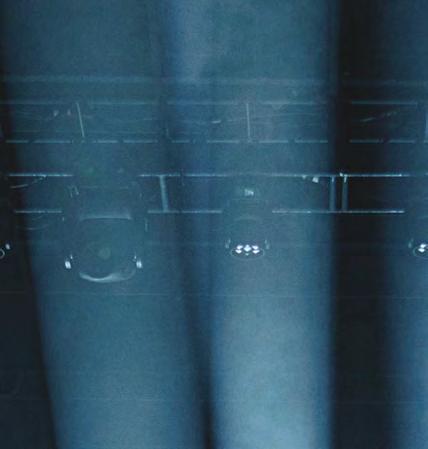
the very high refresh rate,” adds Hartono. In addition to boom and grip cameras, the church ordered several Blackmagic Design 4K Pocket Cinema models. Currently eight video inputs are routed to the switcher, including a Steadicam camera mounted on a dolly track, a Mac Mini and two iMacs for playback together with a PC.
The focus for GBI video editor Lukas Setiawan each Sunday is an impressive 4mm pixel pitch Leyard LED wall behind the stage. Fixed in an L-C-R configuration, the central LED wall measures 15m x 6m (WxH), with left and right sections each measuring 4m x 5m (WxH). Various input signals can be output to the LED components without any delay once processed through a MIG Cyclone CL9400 videowall controller.
The friendship and trust that has developed between Andy and Jendrah over the years has matured to an almost subliminal understanding. By integrating powerful, renowned and intuitive audio and lighting technologies in a bespoke manner, ASIIS has maximised the worship experience within and beyond the newly constructed GBI Keluarga Allah PIK.
visual environment technologies etcconnect.com etcconnect.com/Halcyon
www.asiis-indonesia.com
The lip of the stage is shared by Clair P8-95 front-fills and Chauvet R3 Rogue Beams
Changing expectations
underneath, backed by a pair of SXCF118 18-inch cardioid subs on each hang, driven by four iKON iK42 2,500W Dante-supporting processcontrolled amplifiers. A further pair of Martin Audio’s high-powered XD12 12-inch point source speakers were deployed as corner-fill, with seven ultra-compact DD6 6.5-inch speakers placed around the perimeter of the stage for close front-fill. “It was having fill speakers around the lip that the old system really lacked,” believes Wright. In addition to providing increased coverage, the new setup also meets the aesthetic requirement, since the ceiling is now painted black, and the speakers blend in well. “The whole thing looks really sleek now,” exclaims Hoskinson.

“When Martin Audio’s Will Harris came to commission it, as soon as it was physically turned on it sounded great,” adds Wright. “It sounded exactly like it looked on the engineering document. Any DSP that was needed was built into the amps.” Hoskinson shares his enthusiasm, particularly since congregants are
BASED IN
DES MOINES, IOWA,
Conference Technologies Inc (CTI) has completed a sound system integration at nearby Grace Church, replacing the former PA, which had serviced its requirements for two decades, with the constant curvature technology of Martin Audio’s TORUS array. This is the latest in a series of AVL upgrades at the church undertaken by CTI over the past 10 years, as it aims to meets the high demands of a Southern Baptist church, whose lively worship ministry is based around bands, choirs and orchestras.

Led and overseen by worship pastor Michael Hoskinson, the old PA, which had been in situ since the church opened, was providing inconsistent coverage across the 1,200-seat fanshaped auditorium and was clearly ready to be retired. “What we were looking for instead was a line array that would provide even coverage everywhere,” says the pastor. The previous system’s subs were also set upfront on the ground and have been visually obtrusive. “And so, we were looking for a system that would enable the subs to be flown and, at the same time, provide better coverage.”
“The frequency response from front to back and side to side was not good, and it had never been tuned to the room,” adds Tim Wright,
CTI’s VP of systems integration. “As technology has advanced and our needs have become more critical with regard to frequency response, so our expectations have changed.”
He made a wish list and discussed his requirements with Martin Audio North America. “We had a couple of runs with their design engineers and felt the coverage maps could still be improved. Then expectations leaned towards TORUS and I knew that solution was spot on. I had heard the system at a tradeshow and knew exactly what it was capable of. Sonically I have always been impressed with the vocal quality of Martin Audio and TORUS is a level beyond that. I tested it with a CD and the clarity was fantastic; for the price point Martin Audio hits, this is second to none.”
Hoskinson agrees. “From the other integrator options I was given, we could have spent double the money for the same result.” In fact, Wright himself had presented four different options, meeting different price points. “When I was asked which one I would recommend, it was a no-brainer.”
Although Wright has long been a fan of Martin Audio, he admits that CTI has only become a recent convert to the loudspeaker manufacturer. “Although
I have installed the brand previously, this was the first big chance to do something of this calibre and size.” However, the Grace Church installation was not without its challenges, including locating the three hang points and a confined workspace above a hard-deck ceiling. But an L-C-R system was duly implemented, with a combination of two TORUS T1215 with a T1230
reporting widespread satisfaction and enjoyment of the new array. And with the fast turnaround of activity within the church, he adds that in the coming months, he will be throwing a lot at TORUS. “These speakers can expect to be pumped harder than they would normally expect,” he concludes.
www.martin-audio.com
22 WORSHIP AVL March–April 2023
PROJECTS
There are two TORUS T1215, a T1230 and a pair of SXCF118 subs in each hang
Martin Audio’s TORUS saves Grace Church from inconsistent coverage across its fan-shaped auditorium

Word of mouth
THE CATHEDRAL OF SAINT
George is set alongside the beautiful Victorian Shephalbury Manor in Stevenage, around an hour north of London. It bears the name of the great martyr Saint George, who is claimed to be one of the greatest intercessors among the Coptic faithful, as well as being the patron saint of England. While being the first Coptic cathedral in the country, it is also the first purpose-built Coptic place of worship in the UK and the second throughout the whole of Europe.
Built in a characteristic cross shape and with traditional Coptic style and decoration, the cathedral is complimented by modern functionality which allows worshippers and visitors to enjoy a comfortable and uplifting spiritual experience. The cathedral has distinctive Coptic elements such as a vaulted roof over the length of the structure and a traditional domed Coptic bell tower that is crowned with a Coptic cross. The interior of the cathedral is decorated with an iconostasis (icon bearer) and intricate, hand-carved woodwork designed and prepared by craftsmen in Egypt.
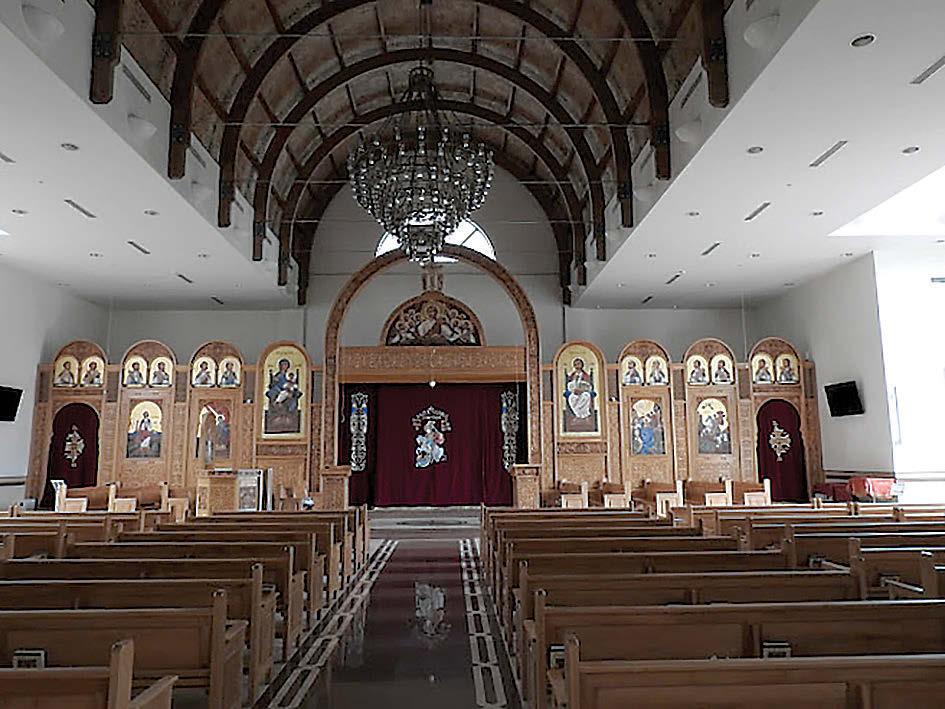
Surrey-based integrator Flipside

AV has been working in the HOW worship sector for nearly four years. “We were introduced to the Stevenage cathedral because of the work we were doing at St Mark’s in Kensington,” explains Flipside
AV MD, James Cooper. “When we were going through the initial design and quoting process at St Mark’s, there was a series of meetings with people from the community. After the proposal had been confirmed at
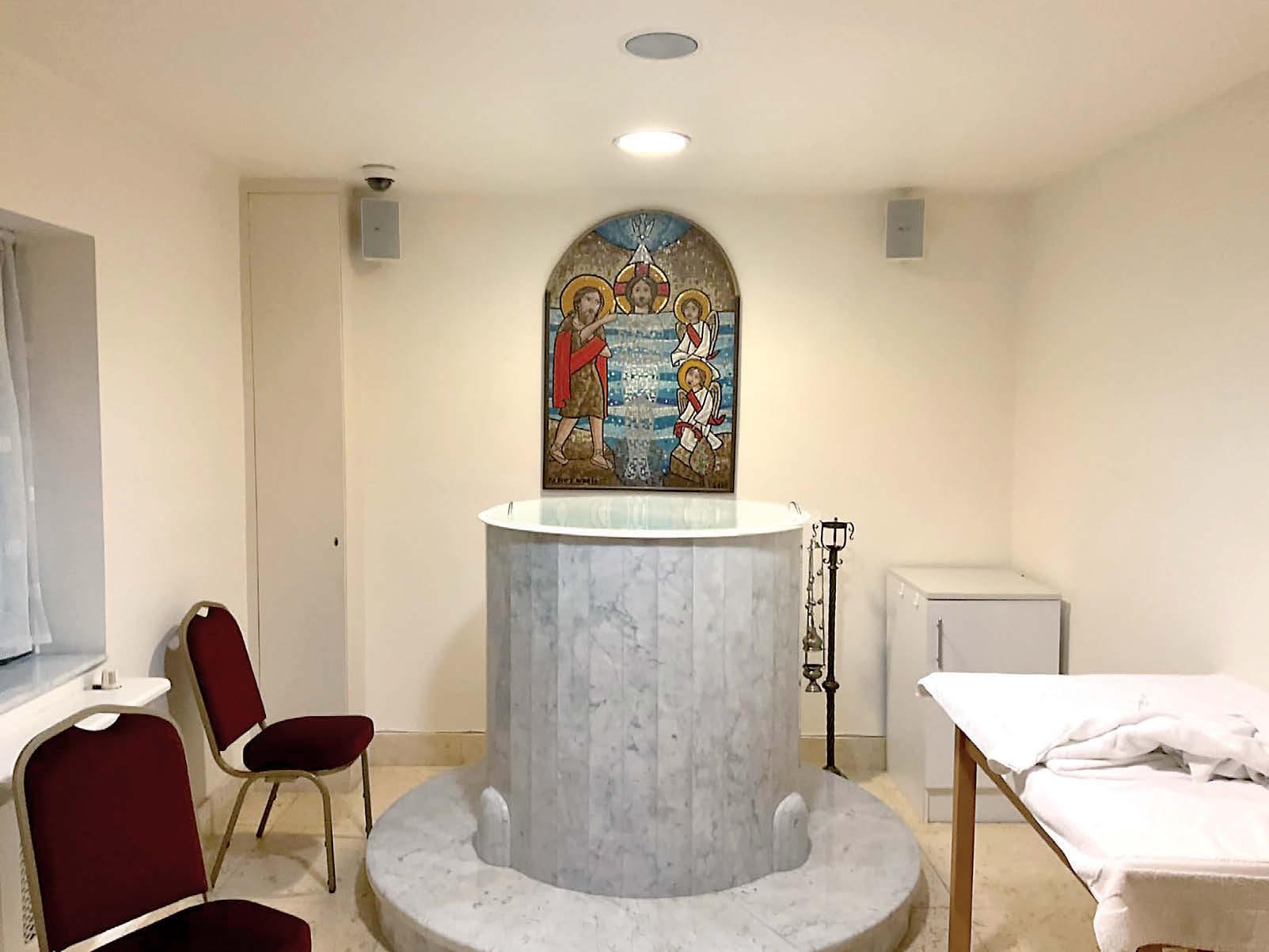
St Mark’s, I was also asked to go and look at the Cathedral of Saint George.”
The proposal for Hertfordshire was only sound in the front part of the cathedral, namely the main space, a baptism room and what they call the upper room, which provides a space for families and children and is a raised, first-floor, glass-fronted room at the back of the main space. “The sound in the main cathedral was appalling and the design of the old system wasn’t much better,” explains Cooper. “In the cathedral, there are clean white walls, tiled floors and high ceilings – a reverberant space. The previous system had been adjusted and retrofitted and the sound had got worse and worse, it was really reverberant and speech was

After supplying a demo system including Yamaha columns and a couple of subwoofers, the cathedral
they were happy with the proposal. “I’ve got lots of faith in the Yamaha system,” adds Cooper. “I’ve used it time and time again and it’s not expensive. It will do a 60m throw without dropping a decibel from front to back and it will keep it narrow. I knew that my proposal would solve the problems the cathedral was having with its old system, which was firing sound out in all directions.”
Once the proposal had been approved by the Archbishop and church council, the installation was able to proceed. “Once they said yes, it was plain sailing,” enthuses Cooper. “The cathedral isn’t an old building so we didn’t have to worry about listed building status and if I had a questions during the installation, it didn’t hold anything up.”
The Cathedral of Saint George is Flipside AV’s second, and hopefully not last, Coptic Orthodox installation in recent months
24 WORSHIP AVL March–April 2023
The installation consists of two L-R Yamaha VXL1-16 columns attached to the wall with two VXS10ST
PROJECTS
Yahama in the rack – an EXI8 input expander for the MRX7-D processor below, and two XMV8140 amplifiers
Yamaha VS4s in the baptism room
subwoofers on the floor. The Yamaha columns have a 10° vertical dispersion and a 170° horizontal dispersion, which is sufficient to cover the entire cathedral space. Two VXS1 1-inch speakers have been supplied for quire in-fill and fitted to the ornate wooden shroud in front of the altar. Two VXS5s have been fitted at the back of the main cathedral space below the baby room by the entrance foyer, along with four VXS5s in the baby room and two VS4s surface-mount speakers in the baptism room.
“It was about getting the system right down to the fewest sound sources possible to cover the area they needed so there weren’t too many outputs,” explains Cooper. “Where possible, I like to have a main left and right system and maybe some delays that are just front firing in a very controlled manner. It’s all about the vertical dispersion and keeping it very narrow vertically and trying to have the bottom of the dispersion hit the first pew and the top of the dispersion hitting the heads of the rear pew, and nothing else is needed.”
The services at the Cathedral of Saint George are entirely speech – there isn’t a worship band. However, Cooper opted to install
the subwoofers to help everything sound more natural. “When you’re using skinny 1.5-inch drivers, I would always want to put a subwoofer in anyway,” he adds.
The new setup has also helped the cathedral improve the quality of the audio for its livestream. Along with the Yamaha speakers, Cooper has replaced several microphones, including Sennheiser wireless gooseneck transmitters for the lectern positions. “We just cleaned up everything that was already there. They’re still using some of the XLR inputs from the floor boxes but
providing them with a Yamaha MTX has given them a clean dedicated feed for streaming that they have some control over, separate to the main output for the PA system.”

Cooper is hoping, given time and budget, to return to Stevenage and complete the work that he first quoted for. The original proposal was for the whole building – in addition to the three areas already in receipt of the new equipment, there are meeting rooms, a large hall that is used for functions and a café area. “We quoted for everything –streaming system, distributed AV,
sound, switching and radio mics. The main church space needed sorting first, as well as cleaning up the audio feed for streaming. We provided a couple of data cables so that the church can patch into its existing Wi-Fi networks and get wireless control and a couple of signal cables to get a fixed feed from the main PA system, independent to the volume in the main PA system. We could go back and sort out their existing system but it will make more sense to wait until they have the budget to upgrade the rest of their equipment properly.”
And it’s not just Stevenage that will hopefully result in further work. Following completion of the installations at both St Mark’s and the Cathedral of Saint George, Cooper is travelling to Birmingham to quote on another project at St Mary & Archangel Michael Coptic Orthodox Cathedral. “The Coptic Orthodox community is one of those faith communities that’s pretty close knit, so everyone knows everyone,” he concludes. Who knows – perhaps Cooper will soon be heading to the airport and travelling abroad for his next Coptic Orthodox installation.
www.flipsideav.co.uk

PROJECTS March–April 2023 WORSHIP AVL 25
Yamaha VXL1-16 columns are attached to the wall
New connections
SINCE THE CHURCH OF THE
Epiphany first opened its humble doors in 1967, an initial lack of chairs and furnishings has been balanced by an abundance in faith over the years. Over half a century would pass before a new church would be constructed on the same site close to Seletar air force base in Singapore. Having relied on offerings such as second-hand pews, a new generation of worshippers gave generously to ensure the church would broadcast its services pristinely and powerfully within and beyond its new five-level home.
The AV and lighting systems gracing three levels of the new construction were similarly provided in charitable circumstances. For a church that was indoctrinated a year following Singapore’s own coming of age, Epiphany reminisces its history with a certain nostalgia. However, the church elders including the vicar’s warden and music coordinator, Abraham Manimuthu, are focused firmly on the future AV requirements for their coming-of-age worshippers.



Having served at eight churches prior to his posting at Epiphany in July 2015, Reverend Paul Xavier arrived off the number 88 bus to enter “a
very rich cultural heritage”. “For me, this was something new as Epiphany is only one of three Tamil parishes in the Diocese of Singapore,” he recalls. The services have predominantly been conducted in Hindi. “From the moment I stepped through the old church gate, it felt like I had arrived home. This is a predominantly Tamil parish and 98% of Epiphany’s multi-generation members are Singaporean Indians who speak Hindi. It’s a remote neighbourhood by Singaporean standards, but people come as they have heard that the church is a great community place with childcare.”
Reverend Paul quickly learnt that a redevelopment plan was nearing fruition and that the church was in the process of nominating an architect. However, there was a significant shortfall in funding required to construct and furnish the church’s ambitious plans. When former vicar Reverend Stephen Archibald arrived in 2017, Epiphany added a Saturday service and the congregations started to grow. This in turn stimulated new interest in the redevelopment project, which led to an approval being granted to continue fundraising.
over Zoom,” adds Reverend Paul. “However, the various lockdowns, a lack of manpower and some workers contracting Covid led to building work slowing down and many fundraising activities being cancelled.”
As the outer skeleton of the new Epiphany emerged in December 2021, a temporary occupancy permit was granted. “From our calculations,
PROJECTS
26 WORSHIP AVL March–April 2023
The Church of the Epiphany has selected Adamson speakers for its multi-level premises in Singapore
Construction of the new Epiphany Church was over three years in the making
L–R: Music coordinator Abraham Manimuthu with Reverend Paul Xavier
Reverend Paul Xavier’s dream has been realised in the fourth-level sanctuary
we still required around S$1 million (US$750,000) to completely furnish and kit out all five levels, including the kitchens and offices, but with tax and inflation this had risen to $2.4 million,” Reverend Paul surmises. Donations continued to arrive, and the committee outsourced the furniture, pews and interior works to be manufactured in Singapore, including cushions for the pews made by the elderly congregants. “We also lacked a good sound system together with acoustic panelling –naturally, we wanted the Lord to help us.”
A pioneer member of Epiphany since its inception in 1967, Manimuthu references that the church previously worshipped in a more orderly and traditional Anglican manner. “Reverend Joseph Kanniah introduced a more charismatic style of worship where we could raise our hands and praise the Lord out loud,” recalls Manimuthu. “To further enhance worship, we staged a live band for our services. Initially just a bass and keyboard player, but then we added acoustic and electric guitars and this in turn drew a larger congregation. Over time, a worship team formed as we required an understanding of the technology to better worship God, which led to investments in synthesisers and electronic equipment.”
When the development plan rolled out, the technicians drafted their own wish list with a cabling infrastructure including SDI, HDMI, Cat6a and IP for remote controlling of the cameras at the top. “I understood their direction as I was previously employed in the satellite business with SingTel,” continues Manimuthu. “We were fully aware of the costs, so we were pleasantly surprised when the church agreed to our plans.”

When the time arrived to source an audio system, Manimuthu realised that there was little budget remaining.
consultant and supplier among the Singaporean church community,” he continues. Having happily operated as an end user over the past two decades, Mathew’s integrity and production values have transformed his status to that of an influencer and, in doing so, has attracted the attention of manufacturers seeking better sales penetration into Singapore. “When Adamson approached me to represent them in Singapore, I was flattered. I had heard about their systems being used by Hillsong and Eighth Day, so that was
Mathew based his proposal for Epiphany around an Adamson IS7 line array system, although the initial quotation exceeded the church’s budget. “Alan’s parents knew the church and, as a result, he had a change of heart,” explains Manimuthu. “After some thought, Alan declared that he would help, and reassured us not to worry about the final price. Alan then introduced me to Colin Quek from LTA, who also assured Epiphany that he would install futureproofed audio, video and lighting components within budget.”
Prior to LTA’s arrival for the AV and lighting fit-out, an IT contractor fulfilled the cabling infrastructure throughout the new Epiphany, including a 200-capacity level-two hall for English and youth services, a 100-capacity level-two hall for Mandarin services and a further level-four 450-capacity main sanctuary for the predominantly Tamil services. Fibre-optic connectivity has been installed between all three venues, promoting the transmission of bilateral AV signals. “We didn’t want to dedicate services to predominantly English, Chinese or Tamil congregations, so we hold them on all three levels,” reveals Manimuthu.
“The cabling infrastructure was advanced and clearly well-designed,” recalls LTA managing director Colin Quek from his initial site visit. “Each level is fibre-connected to a main rack with AV data routed to Netgear Pro AV switches, allowing the technicians to make changes easily with a drag-and-drop GUI. The backbone Dante and AV-overIP network protocols here can be managed by a layperson. However, the church was less familiar with the need for redundancy and so we needed to build more of this into the system. AV flexibility has also been extended and the Epiphany network can now handle an increased signal
transport capacity, including all the 4K cameras and the PTZs.” Should a service be conducted on the second level, the church can ingest the signals directly from the cameras downstairs to the displays on the upper levels from the control surface in the main sanctuary. “NDI is very easy to use,” continues Quek. “An operator has a visual of every single NDI source
production, there are many possibilities. For example, a worshipper can be seated in the sanctuary and participate with any programme that is available to stream as a mix down source.”
Established in 2019 as a new professional audio distributor in Singapore, Mathew heads M3 Professional Audio (M3PA). Differentiating itself as a specialist supplier to high-performance entertainment venues within the city state, M3PA created a simple L-R design for the main sanctuary comprising six IS7 enclosures in each hang, augmented by four floor-standing IS119 subwoofers. Powered by one Lab Gruppen D80:4L and three D120:4L amplifiers, a pair of Adamson IS7px passive point source fills with rotatable prolate spheroidal waveguides complete the inventory. The audio setup


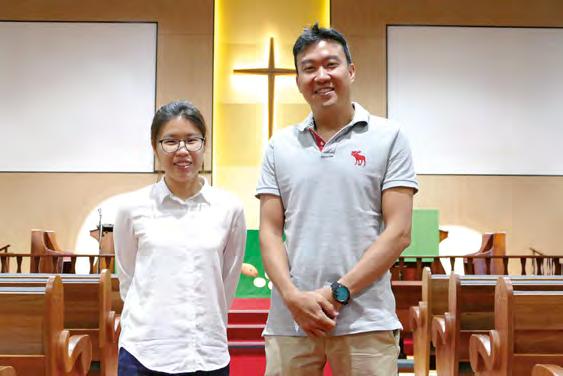
PROJECTS March–April 2023 WORSHIP AVL 27
L–R: LTA’s Kheng Ying Koay and Colin Quek following commissioning of the audio system
The Sunday service as seen from the Midas M32 mix position
A Midas M32 40-input digital console at FOH
Visual inputs in the main sanctuary include three Bolin Technology PTZ cameras
is connected using Sommer 4SQ-mm and 8SQ-m cabling.


“When we were commissioning the Adamson IS7 loudspeakers without subs, they delivered a lot of punch at 80Hz,” exclaims Quek. “This is the first time that LTA has installed Adamson and I can testify that they are very powerful for their size.” The two-way line array cabinet contains dual ND7-LM8 woofers and a 1.4-inch exit compression driver coupled to an optimised waveguide to create a slightly curved wavefront with a nominal dispersion pattern of 100° x 12.5° (HxV). The inherent Controlled Summation Technology (CST) further eliminates low-mid lobing normally associated with two-way line source systems.
Having taken the decision to install Adamson loudspeakers at the outset of the AV and lighting fit-out, other elements including the audio mixing console were specified along the way. “Manimuthu and the technical team requested a user-friendly digital control surface and personal monitoring system for their services,” explains Quek. “As such, we had no hesitation recommending a Midas ecosystem as this ticked all their needs and, importantly, it fell within their budgetary requirements.”
Two DL16 stageboxes combine to feed 32 inputs and 16 XLR outputs to and from the Midas M32 40-input live console. Providing up to 96 inputs and 96 outputs over the AES50-B network, the M32 is fitted with a DN32-Dante expansion card that allows 32 channels of networked audio to be transmitted bidirectionally. The eight XLR returns at the stage end and the Ultranet output connect five Midas DP48 personal monitor mixers used by the musicians onstage via a Midas HUB4. The HUB4 collects 48 channels of audio and forwards them to the M32 console from the DL4 stageboxes via AES50-B connection.
“An engineer can broadcast streams to the Midas DP48 personal monitors,” explains Quek. “Once channel naming has been programmed on the console, there is no further need to set the personal monitors individually. You only need to press a button to receive a broadcast on the audio channel. Whatever name the engineer has programmed on the console, the musician also has the same name on their personal mixer.”
To select the correct microphones for their needs, LTA provided demonstrations of leading brands. Following this, the Epiphany singers and church elders use Sennheiser


Midas DP48 personal monitor mixers are used by the musicians
e835 handhelds onstage for transmission to four EW-D wireless receivers and the choir is equipped with Audio-Technica microphones. “For the pulpit, the pastors agreed that the Earthworks FMR600 could not be matched in terms of vocal quality reproduction.” A smaller pulpit is outfitted with an Audio-Technica U859QL cardioid dynamic gooseneck mounted on an AT8647QM/S shockmount plate. The musicians elected Audix microphones, including the percussionist who has mic’ed his overheads with D2s. The snare has
been fitted with an i5, toms with D4s and a D6 on the kick drum.
Like the Adamson loudspeaker system, the video requirements were selected earlier. “The worship team specified a basic level for projection owing to financial constraints. However, we ultimately supplied a very high impact system on a relatively low budget,” adds Quek. Inputs including three Bolin Technology PTZ camera units, a Mac and a computer are routed to Blackmagic Matrix SDI and Roland V-160HD switchers. “The video inputs are routed to two
Built to last
For 70 years Made in Germany

PROJECTS
www.k-m.de
Put your equipment on a sound footing with a König & Meyer stand. Robust and durable, it will be your companion for a long time to come. Made in Germany from finest quality materials and according to our high-quality assurance standards. Rely on innovative designs and user-friendly functionality, plus a five-year warranty.
switchers in the sanctuary production area. The Blackmagic Matrix SDI switcher outputs to the two L-R projection screens from two ceilingmounted Maxell MP-WU8101B LCD projectors. Fulfilling the church’s hybrid requirements, the Roland V-160HD is a powerful streaming switcher that broadcasts HD and SDI content over the IP network to the lower levels in addition to remote worshippers.”
To attain the optimum sound reinforcement in the sanctuary, LTA also recommended Primacoustic panelling, including roof and wall treatments. Providing comprehensive electrical protections such as power surges, the addition of two Furman CN-3600 SE 16A power sequencers promote simple on/off of all the technical equipment. The Chauvet lighting system includes moving heads and SlimPARs.





The lower-capacity worship spaces on the second and third levels are equipped with smaller-scale setups. Level two is equipped with two AV Matrix PTZ camera units, an AV Matrix six-channel streaming switcher and two Blackmagic Smart Videohub Ultra HD routers. “The video mixer on the third and second levels are a lot simpler, but they also provide streaming,” adds Quek. “When plugged into a laptop, the operator
can ingest the video feed without a computer.” In addition to providing
two musicians with DP48 personal monitoring mixing, a similar Midas mixing ecosystem outputs to dual Adamson S10p loudspeakers augmented by twin Adamson IS119 subwoofers. A Sennheiser EW-D wireless system together with an Earthworks FMR500 gooseneck fulfils the microphone needs.
“The delays caused by Covid-19 were a huge constraint and the works took a lot longer to complete than planned,” assesses Quek. He was quick, however, to credit the church volunteers who assisted LTA in delivering the AV and lighting package. “Fortunately, many of the church volunteers stepped in, taking on vacant roles, and the Music Ministry also helped enormously.”
They were also quick learners, furthers Quek. “Having added plenty of flexibility and ease-ofuse features to the design, we then trained the technicians and operators. The video mixer is simple to understand and is probably the most adopted mixer among houses of worship and rental companies. Most freelancers are familiar with it and new operators can access resources online such as YouTube
to learn parts of the mixer they may not be familiar with.”
Now well-acquainted with both Mathew and Quek, Manimuthu feels blessed. “Their assistance in sourcing these products and installing the equipment including the cabling, SDI encoders and HDMI connectors was so professional. Epiphany entrusted them and they did not disappoint. We were all so impressed with the sound quality when they finally commissioned the
system. LTA made it so easy for us by taking away all our worries and adding so much futureproofing into the setup.”
When the development plan was rolled out, Reverend Paul admits that there was an innermost doubt in his mind that the dream may not come to life. Now marvelling at the AV setup within the main sanctuary, he feels equally blessed by the events that led to the completion of the newly constructed church. However, he is not taking anything for granted and, as his journey to his ninth church awaits, he is entrusting the younger generation to look ahead to the future.
“I continue to remind the technical operators that they will need to upgrade the current setup over the next two decades and, as a result, keep up to date with current technological trends. They should not forget the people who designed this system. I hope that the synergy, the cooperation and the relationship continue between LTA and the younger generation as we cannot forget what they have done for us.” Having played a large part in bringing the new Epiphany to life, LTA will maintain a presence during every service for many years to come.
www.churchoftheepiphany.sg
www.loudtechnologiesasia.com


Constant Curvature Array Element

PROJECTS
Build Up your Horizontal,
or
in 20° building Blocks ONE SLICE MANY POSSIBILITIES Seamless Transition Waveguide STW www.axiomproaudio.com AX1012
Dual Adamson IS119 subwoofers are installed directly behind the six IS7 line array hangs
Vertical, Down firing
Stacked Array,
Hearing loops
A HEARING LOOP, ALSO KNOWN as an induction loop or T-Loop, is an inherently simple assistive listening system which provides access to facilities for those with a hearing impairment. Most hearing aid users would say that when they use their aids in one-to-one conversations, they work incredibly well. Difficulties arise when the level of ambient noise is too great or the distance between speaker and listener is increased, as can frequently happen in a place of worship. Hearing loops take a sound source and transfer it directly to a user’s hearing aid, bypassing background noise. This approach also offers other benefits such as better freedom of movement by ensuring a consistent signal throughout the looped area, reduced overspill and interference between neighbouring environments or the unwanted possibility of broadcasting sensitive information.

Furthermore, the number of users who can benefit from a loop system at one time is only limited by the number of people that can fit in a “looped” area. Expensive receivers are not required, and users don’t suffer the inconvenience of asking
for and wearing a headset, which could be uncomfortably visible. Plugging your AV system directly into the loop, alongside a good-quality dedicated directional microphone sat close to the orator’s position, will provide ideal results in all scenarios. But, of course, HOWs are far from uniform in their design and different types of worship often present different challenges or attributes that are also useful to be aware of. After decades of its assistive listening solutions being integrated in house of worship settings, Ampetronic’s guide highlights some of the main key differences when it comes to using loops in modern HOWs, mosques or traditional church settings.
Modern church buildings
Most congregation areas in modern churches are regular in shape, making loop installation relatively simple. However, the best loop location will depend on the design of each individual building. A preacher’s voice reduces in volume by half for every doubling of distance. So, any member of the congregation

sitting past the third row may find it difficult to differentiate between the sound coming from the preacher and ambient background noise.
It is preferable to loop the entire space wherever possible, so as not to discriminate by separating hearing aid users from the rest of a congregation.
In modern buildings, there can be a number of areas that do not conform to simple geometry, making hearing loop installations much more complex. In these circumstances, a multi-loop system, with lowloss or low-spill functions where required, will provide the needed coverage. Areas that can be divided, or expanded dynamically, as need
dictates, may also require more complex solutions for assistive listening.
Modern buildings tend to have some form of metal content in the floor such as mesh reinforced concrete or raised access floor tiles. The effects of metal on an induction loop can be significant and, as a consequence, magnetic field strength and high frequencies may be attenuated, which reduces intelligibility and overall volume. Metal content needs to be considered at the design stage of a project.
Mosques
Contemporary mosques are broadly classified by size and location in relation to the community they serve and can include masjids and musallas plus a variety of other spaces in which members of the community gather to perform worship and social activities. Worship in a mosque consists of two main modes: prayer mode, with worshippers standing, bowing, prostrating or sitting; and preaching mode, where worshippers are directly seated on the floor in rows facing Mecca.

KnowHOW
Ampetronic has produced an application guide for its hearing loop products outlining a variety of common house of worship settings
30 WORSHIP AVL March–April 2023
Diagram of how hearing loops work
When praying in a mosque, a variety of physical positions are executed, including bowing, where a worshipper bends over until the forehead is touching the floor, making the hearing aid (and T-coil within) nearly horizontal. In this position, the electrical current induced within the hearing aid’s T-coil will vary and may cause the signal to fade, making a conventional perimeter loop system problematic. In most cases, this signal variation is manageable, with appropriate equipment, design and implementation of a phased array system that can accommodate variations in head position.
Where mosques accommodate male and female worshippers (via a separate annexe, area or even mezzanine floor), it may also be important to control overspill to maintain confidentiality and minimise disruption.
In general, traditional mosques can be classified according to their architectural type and style. Building composition and scale will vary greatly and geographical location will also play a role in determining the exact requirements for a hearing loop system. System specification is important in mosque applications –the building construction, architecture
result in poor or unusual acoustics that make intelligibility for hearing aid users difficult.
Cathedrals and traditional church buildings
Unlike modern church buildings, traditional churches and cathedrals, particularly those built before the 19th century, have less metal in their construction,
trench around the perimeter of the building.
Cathedrals with ceiling heights up to 100m allow for more flexibility with loop installation, particularly if a single area or zone within the whole building is being looped. It is common to place a perimeter loop, either around the upper part of a wall or, in the case of large cathedrals, in a service walkway or triforium. Alternatively, sections of a floor space can be covered, for example pews, with a low-loss multi-
suggests the following list of questions to consider as a starting point:
• What type of system is needed?
• Are there any other loop systems nearby?

• Are there issues of confidentiality between areas? Do you have scaled plans of the rooms and areas to be covered?
• Is any metalwork contained within or close to the loop area? Is a flat copper tape suitable for installation under carpets and flooring preferred, or a copper wire for fixing to walls or ceilings?
brick floor. In these instances, the more common approach is to place a perimeter loop 2.5m
highlighting as they aren’t necessarily obvious considerations to those with limited experience with loops. To
The requirement for innovative assistive listening solutions is often amplified by the sheer size of house of worship buildings and the fact that they tend to be highly multipurpose in nature. The full Ampetronic Application Guide can be viewed at www.ampetronic.com/wp-content/ uploads/UP30171-1Houses_of_Worship_App_Notes.pdf and is well worth a read before starting out on your hearing loop journey.

KnowHOW March–April 2023 WORSHIP AVL 31
The C Series can be used as a perimeter loop or multi-loop system
House of worship: delivering the best congregation experience
POST-COVID, MANY HOUSES OF worship are facing challenges regarding how to bring a new level of coherence to worship events, while also having a positive effect on attracting new parishioners, including those viewing at home. In this blog, Green Hippo aims to help house of worship AV and IT managers and volunteers understand the central requirements of connectivity, managing multiple sources across several displays on multiple walls, and how to offer seamless, yet simple control.
As the world continues to change, houses of worship will increasingly demand flexible installations that allow them to continually adapt to future challenges without costly reinvestment in core equipment. In essence, the AV and IT managers/volunteers in house of worship facilities have three demands they are facing:
1. Upgr ading existing facility infrastructures with the latest technology allowing remote parishioners to interact as if they were in the same room as the rest of the congregation.
2. Inst alling new, larger, LED or projector edge-blended walls for in-person, hybrid or fully virtual services so that all parishioners can become engaged.
3. Creating an overall system that volunteer AV techs will enjoy using by delivering simple, yet powerful control.
Simple control setups
As the old mantra says: “Time spent on preparation is rarely wasted”, meaning the early efforts spent in the design phase will pay real dividends later, by helping to create seamless workflows, while also saving time and money. This includes carefully considering the options for controlling the system by the AV team or, in smaller houses of worship, volunteers.
One option to overcome this issue is smart phone and tablet apps that are available for iOS and Android devices. These apps should be simple to use while having enough control for the application. Ideally, techs will be able to select different video window arrangements on the wall and select which sources go into those areas.
Connectivity
Whatever your videowall design looks like, the video processor will not deliver if it cannot manage the basic challenges of AV design, including setting custom resolutions, EDID selection and HDCP management. You cannot risk having a blank source or feeding inferior quality video to your expensive wall. To avoid this, make a list of all your sources and displays, including the resolutions, frame rates and HDCP versions. Then, check that the solution you
have chosen can support all these factors.
Multi-windowing
Once you have decided to embrace a hybrid system, you are ready to enjoy the benefits of a collaborative, multi-window environment beyond the capabilities of Zoom and MS Teams. The best solutions can display one or two sources, right up to 128 windows on your LED, edgeblended projectors or multi-screen videowalls.
The “Zoom Generation” increasingly demands attentiongrabbing, multi-window environments as standard. Before choosing a solution, check the actual number of windows that are available, including the scaling quality and the video latency. Also, make sure you see a “clean” cut or fade to black when you switch between your window sources, even when the resolution/frame rate varies between those sources.
Displaying across multiple walls
Many houses of worship require more than one videowall. For example, you may deploy a large background wall, either LED or projector edge-blended, but also have large side displays to help convey your message. Of course, one option is to add additional processors; however, this increases the system cost by
adding extra infrastructure, matrices and cables. Control will be far more complex; therefore, it is far better to use an all-in-one device. To avoid these pitfalls, check if your chosen videowall processor can output and then independently control more than one wall. Also, check if it has built-in video switching capability.
Consider going beyond 16:9
A common limiting factor for the creation of larger, background displays is the height of the room. In this case, creating a stunning extra-wide display, with LED or edgeblended projection can create extra visual space to collaborate and will undoubtedly be a real draw to bring worshippers in. An easy way to take your extra-wide content delivery to a new level is to add an advanced media server into your technology mix. This will mean you can deliver incredible vistas behind your services and celebrations which will instantly and seamlessly set the scene. When you go beyond standard widescreen aspect ratios, it will be distracting if the video is not displayed in the correct ratio, so check whether you have full control over the aspect ratios. Also, ask how a 16:9 image will appear when stretched across the full wall and whether extreme upscaling will result in visual artefacts.

In this blog, Green Hippo is aiming to help worship AV and IT managers and volunteers understand the central requirements of connectivity
www.tvone.com 32 WORSHIP AVL March–April 2023
Image courtesy of Glow Church
MAUI® i 1




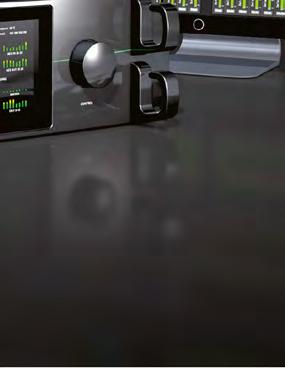
PASSIVE INDOOR/OUTDOOR INSTALLATION COLUMN LOUDSPEAKER



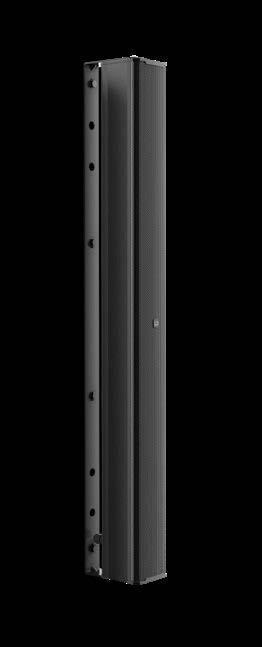








For acoustically challenging interiors where music and speech must be clearly understood, even in the rearmost rows, there is one solution - MAUI® i1. For outdoor use, MAUI® i1 features weather treated cones, an aluminum loudspeaker grille and a weatherproof cover for the connection panel.

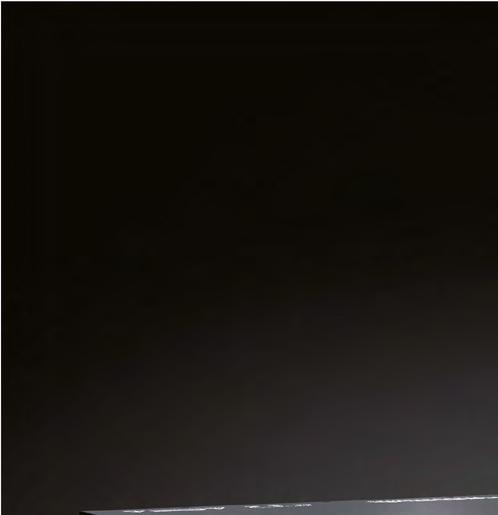
YOU WISH! modular and scalable signal processing analog, digital, network audio PRODIGY Series
www.directout.eu AS
LD Systems® is a registered brand of the Adam Hall Group. DESIGNED & ENGINEERED IN GERMANY
ld-systems.com/mauii1
reach everyone in the audience
What is your Why?
I RECENTLY ATTENDED A LARGE church in the US for a couple of Sunday worship services and found myself being distracted and confused by their lighting choices during the service. Granted, when I am home, I will attend my home church exclusively and won’t get out to other venues to experience for myself the worship environments that they create. Due to Covid over the last several years, this has meant that my time away from other worship services has been even more prolonged than normal due to travel restrictions. Therefore, it may be that I am “behind the times” or am finding myself “out of the loop” when it comes to lighting trends in worship services but, nonetheless, I found that my own reaction to the experience was disjointed and distracted.


As a result, I wanted to take this opportunity to reflect on that experience and challenge you to do the same. The overarching question that I found myself asking as a lighting designer and technician boiled down to a multifaceted, though single question: “Why?” Why do we talk about lighting in a house of worship? When a lighting choice is made, why

was that choice made? Why was a particular colour chosen? Why was there a lighting cue at that point in a worship song? Why was a particular gobo or image used? Why does lighting have such an effect on human emotion and psychological response? Why is it important to be intentional about how we create the worship environment? Why are congregants coming to the worship service in the first place?
My experience left me asking the question “Why?” over and over and it was because I couldn’t answer that question. Let me briefly describe the service that I experienced.
When I walked into the auditorium, the house lighting was warm and inviting and the stage was lit festively for the holiday season, as I would expect for this time of year. Background music was playing quite loudly, which made conversation with others difficult. A few minutes before the service began, a countdown was played on the screens and then the event (I use that term intentionally) began. During the worship portion of the service, the house lighting dimmed to nearly black and the stage
became the focus. Each worship song had its own colour palette and look, quickly crossfading (almost snapping) between the song palettes without much reason. Automated instruments were programmed with dynamic chases during different portions of songs, including pointing the lights directly at the congregation, as is frequently experienced at concert events. The music was loud and it was difficult to hear myself join in the singing, much less hear others in the congregation standing immediately around me. After the worship, the house lighting came back up for the rest of the service (spoken elements) until the worship set at the end of the service, which repeated the lighting experience from the first set. You get the picture. Why? Each lighting cue or look during any event, this service included, is intentionally programmed and decided on by the lighting designer or technician. Why were these choices made? Did they contribute towards the worship experience? What message was trying to be conveyed through the lighting choices? While the lighting didn’t look “bad”, why did it distract me from
One of the most important things to remember is
the reason I was in attendance? As we are still at the beginning of this new year, let me challenge you to ask yourself “Why?” when making lighting decisions and to give yourself an honest answer. And let me further challenge you to think about and consider two specific areas when answering this question.
KnowHOW
John Black aims to help lighting designers make more informed decisions about how they can use the craft of lighting for maximum impact
34 WORSHIP AVL March–April 2023
Lighting doesn’t have to be flashy or concentrated on the stage area to create an impact
Think about how your lighting
Spectators or participants?
In a house of worship setting, one of the most important things to keep in mind as a technician or designer is the congregation that is gathering
especially in very large houses of worship, that end up treating congregants more as spectators at a large event.
What decisions are you making in your lighting choices that treat congregants as spectators or as participants? What decisions tend to lead towards one or the other? Think about choices regarding your house lighting. Think about choices regarding the stage lighting throughout each element of the worship service. Think about how your house lighting and stage lighting work in tandem and can either break down or create a barrier between those onstage and in the auditorium. How can you use colour, intensity, texture, movement and distribution in your lighting to encourage participation in your services? Have you ever asked those in your congregation for feedback as to whether or not your lighting choices help to usher them into worship or merely create an engaging, “fun” atmosphere?

to worship. Are they spectators, simply attending the service and taking in a performance or event, or are they participants coming to engage with and take part in a worship experience? I would argue that congregants are coming to participate in worship, but it is so easy to make technical decisions,
I think that this is something that too often gets overlooked or that we forget about. It is easy to get swept up in the excitement of new gear, new production trends, event details and more, such that we forget why we do what we do and what the ultimate goal is: to allow congregants to worship! When we put ourselves aside and think about all of those gathering together to
worship, then we can make more informed decisions about how we can use the craft of lighting for maximum impact.

Concert, theatre or other?
You may find this an odd question to ponder, but I do think it is worthwhile. The field of lighting is wide and touches many different artforms and industries. Whether music, dance, theatrical, themed entertainment, architectural, interior design or worship, lighting has a profound impact on the human experience of our environments. House of worship lighting is touched by trends from all of the different fields of lighting, taking elements from many different forms and informing choices that worshippers experience from the moment they enter the worship facility through the entire service experience. Regardless of which form your design leans predominantly towards, I challenge you towards a statement that I love and keep in mind with all of my projects: Tell me a story.
As I described the service that I experienced, there lacked any element of story in the lighting choices that were made. In concert lighting, each song will often begin and end in a blackout, allowing a new look, palette or theme to be made in accordance with the message of each song. While there certainly can be and often is a story in a concert experience, in many house of worship settings, I personally find the “beginning/ ending” nature of individual songs like this to be distracting as the purpose of the worship experience, or the main message of the service, more often than not is consistent throughout the entire service. Each service element is chosen and crafted to take the worshipper towards and through the act of worship, and the lighting choices should likewise support this goal. I would argue towards considering a worship service as a unified whole, rather than a collection of individual service elements.
Think about how your lighting moves the service “story” from beginning to end. How do you use lighting to transition between service elements to flow between “story” elements? Think about how your lighting directs the attention of congregants and moves them into and through the worship experience. Human eyes direct our attention and
focus so powerfully. How can what your congregants see or where their focus is directed assist them in their worship? Or distract them? How can you use colour, intensity, texture, movement and distribution to tell the story of your service?
Immersive lighting
My own experiences and training in lighting predominantly come from the theatrical field, so that greatly informs the lighting choices that I make in all of my projects. But what truly interests, excites and inspires me is what I refer to as immersive lighting – bringing together all the various techniques from the different lighting disciplines and creating a full experience in which everyone – presenters, performers, audience or congregation – all become participants together. In my own work in theatre, which traditionally is a presentational form observed by an audience, I try to intentionally immerse the audience through my lighting choices and the same can be applied to the worship setting as a means of drawing congregants into the worship experience.
I’ve found that lighting doesn’t have to be flashy or concentrated on the stage area in order to be high impact. Sometimes the subtlety of having lighting in and around the auditorium that connects with the visuals onstage is all that is needed. As I’ve mentioned before, think through the interaction between the house lighting and the stage lighting. Is there an invisible barrier that can be broken down to create a more immersive experience? Also, how can the presenters on your stage be lit so as to ensure their visibility while at the same time ensuring that they aren’t there for “show” but rather to guide and usher the congregation into worship?
What is your Why?
Perhaps this article was too heavy on the questions, but all of these questions are worthy of consideration. At the end of the day, those attending the worship service are there for one thing – to worship – and our lighting choices can either help usher them into that or, unfortunately, hinder them.
As you are hopefully seeing more and more attendees in-person at your services, what lighting choices are you making in these areas? What is your Why?
KnowHOW March–April 2023 WORSHIP AVL 35
that the congregation is gathering to worship
moves the service “story” from beginning to end
What’s next for stage monitoring?
OUR RECENT MULTI-PART series on immersive audio systems in house of worship settings was largely focused on the cabinet end of the signal chain. Attention naturally shifts to these types of solutions when looking to provide the audience with something new. Yet, immersive soundfields provide benefits in many domains, with one component often overlooked being performers or presenters onstage.
There are several good reasons for using in-ear monitors over floor monitors onstage, but one of the major drawbacks has typically been the loss of spatial localisation. For a positive IEM experience, it therefore becomes all the more important to provide musicians with a spatial mix.
The reason why immersive mixing with systems such as L-ISA, Soundscape, SpaceMap Go and Atmos has been gaining traction is because they deliver an audio experience that is similar to how humans actually hear in real life. As much as we have become used to it, stereo is synthetic. Real-life sounds dissipate in all directions.
Think of a standard, high-quality stereo in-ear mix. You perceive the elements panned in varying degrees from dead centre all the way out to the peripheries of your ears. Maybe you’ve
created some sense of depth with the different levels and EQ of those elements and some atmosphere with reverbs, but that’s about all you can do. The extra brainpower required to transform that two-channel information back into usable information inside our head takes effort, leading to our ears and brains getting tired. This often results in musicians turning up their mixes in an attempt to hear better. It’s a vicious and self-defeating cycle that can ultimately end in permanent hearing damage.
Immersive mixing removes this part of the equation. Having the elements placed all around listeners as they would hear in the world naturally, leaves the auditory system with no additional work. Musicians and artists love it because (if done right) it can feel as though they’re standing onstage with IEMs removed, yet they can hear everything at the preferred level, even elements that make no acoustic sound.
The world of 3D IEM mixing is still quite new, with only a handful of manufacturers creating specific solutions to address the problem. Typically, two pieces of equipment are needed: an audio processor capable of creating a spatial mix and, for greater flexibility, equipment

onstage.

Arguably the current leader in this field, Audiotonix-brand KLANG has built up an ecosystem of immersive listening products spanning practically every possible use case to allow the monitor engineer to “place” different inputs in various areas around the listener’s head in a 3D spectrum.
KLANG:vokal and KLANG:kontroller are the latest products in the German brand’s range. KLANG:vokal is its newest immersive mixing processor –a single rack unit processor that
to 24 mono or stereo channels out of 64 Dante and MADI inputs. Mixes can be sent out via MADI to a console or via Dante to KLANG:kontrollers, which then enable musicians to control their own IEM mixes directly from the stage. One of the benefits of KLANG being an Audiotonix brand is that it natively integrates with DiGiCo consoles, a popular choice of mixer inside many houses of worship. As a result, users can also take advantage of the full workflow implementation on the surface of their SD or Quantum
TECHNOLOGY 36 WORSHIP AVL March–April 2023
KLANG:kontroller in use onstage at Broadmoor Church
desks. Furthermore, KLANG has teamed up with DPA to integrate DPA’s 5100 Mobile Surround Microphone, replacing the need for large quantities of mics to capture the surrounding environment.
For a different approach, 3D monitor mixing in real time is now possible by running Waves’ immersive 3D audio plugins, such as Nx Virtual Mix Room and Abbey Road Studio in ultra-low latency on the Waves SoundGrid platform. Like the KLANG options for existing DiGiCo users, Waves SoundGrid and eMotion LV1 console users can bring immersive monitor mixes into their existing workflow with relative ease. An LV1-based system is capable of facilitating distinct 16 monitor mixes, and the Waves MyMon Personal Monitor Mixing App allows all 16 to be further tweaked onstage via performers’ smartphones.
There are other approaches to introducing a sense of space to traditional stereo mixes. ASI Audio takes a slightly different tactic, marketing its 3DME Active Ambient IEM solution as the only IEM with built-in active 3D ambient microphones than can be tweaked and customised directly from an app on the performer’s smartphone. While this doesn’t create a full 3D
sound mix, it does capture the surrounding ambience in 3D – great for hybrid setups combined with floor monitors to create more natural localisation. The recently released second generation of the solution consists of Active Ambient earphones with embedded binaural MEMS microphones, a bodypack mixer/ controller/DSP processor/headphone amplifier and the Bluetooth-enabled ASI Audio app for control. The app allows for untethered adjustment of the system’s seven-band stereo EQ and limiter threshold and the saving and recall of user presets to ensure repeat access to preferred sound signatures.
The ASI solution also differs in that it has been designed to work with
standard wireless bodypack receivers; however, two separate sources are mixed via the bodypack. One is the IEM mix created in the monitor console, fed to an IEM transmitter of your choice. The other signal is the room sound captured by the binaural microphones. The 3DME system is a novel approach that solves the


issue of IEM isolation, while providing a form of 3D sound reproduction at a price point that’s affordable for most working musicians or houses of worship. Its use could be particularly beneficial for pastors or presenters that need to wear IEMs but don’t want to feel “sealed off” from the audience.
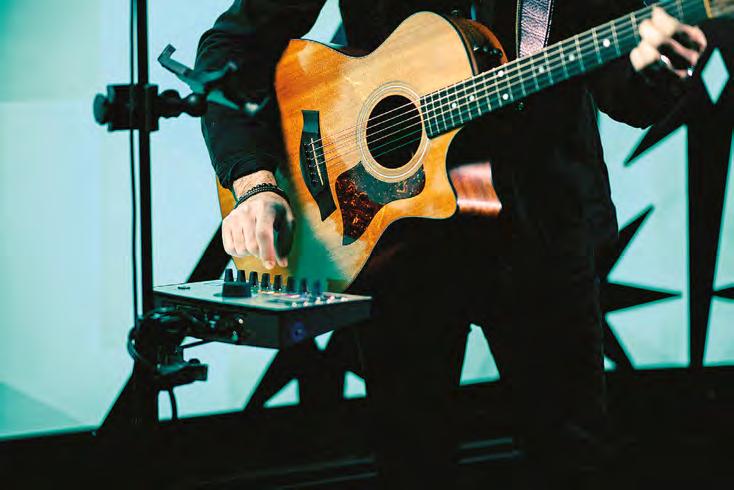

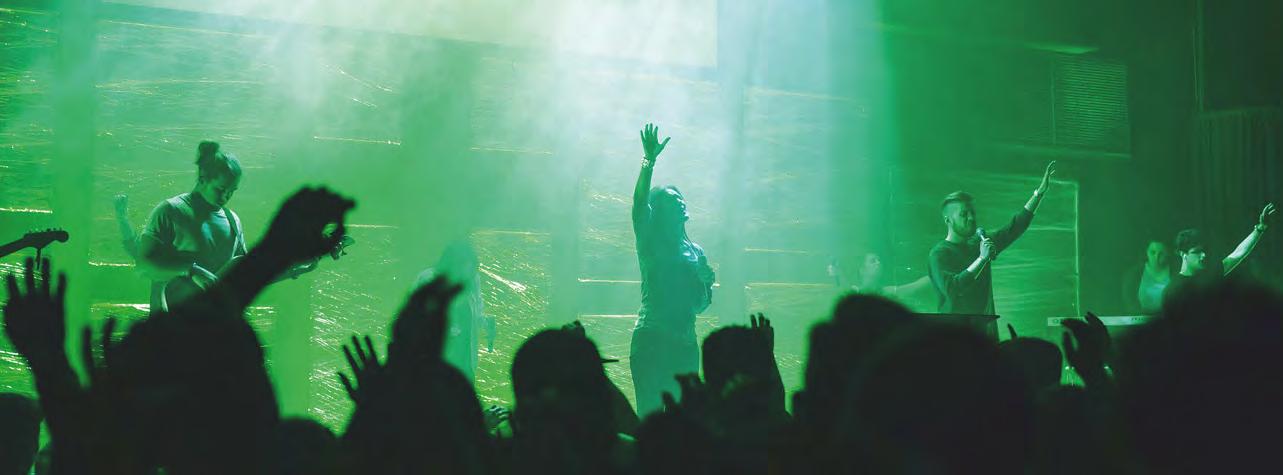
Of course, these are just a few of the more popular systems on the market – a market likely to mature a lot over the next few years. Beyond the stage, taking the step of creating a multichannel immersive mix can offer additional playback benefits, even for those congregations that don’t have an immersive system in their auditorium. While the obstacles that prevented people from worshipping in-person from 2020 onwards have largely now subsided, they led to an ongoing trend of greater online viewership. A sizeable proportion of that online audience will be wearing headphones and can also receive an audio feed that benefits from greater spatialisation. It might be worth considering whether any more of your HOW audience could benefit from “going 3D”.
www.asiaudio.com
www.klang.com
www.waves.com
TECHNOLOGY unmatched ease of use ® advanced audio processing ® livestreaming capabilities Captivate your congregation with powerful presentation experiences using Analog Way’s new high-performance multi-screen and multi-layer 4K60 presentation switchers. www.analogway.com info@analogway.com New! Alta 4K Presentation Switchers Designed for houses of worship requiring the highest reliability and performance Image: Pexel.com/Georges-webster
ASI Audio’s 3DME
Waves’ Nx Virtual Mix Room
Cameras or lunch?
Casey Hawkins recommends that houses of worship should buy the best cameras


in Tyler, he spent the past 25 years in broadcast television working for multiple television stations in the US. He has worked as a broadcast technician for a major telecoms company, managing national and international television broadcast signals over a switched fibre-optic network. He also owned and operated an independent video production firm in Tulsa, Oklahoma for 10 years before returning to Tyler in 2016.
I RECENTLY SPOKE WITH A worship leader about cameras and he said he would rather spend less on cameras for the church in order to spend more money taking volunteers out for meals and building relationships with them and the team. My heart sank. Not because I don’t believe in building a team or in fellowshipping with my fellow believers, because that is imperative, but it’s because I realised I was speaking with someone who did not agree with the very basis of my experience of over 30 years in TV broadcast and production, both in the church world and in the secular spectrum.
I respect this worship leader for what they are, which is a worship leader, just as I hope he respects me for what I am, which is a professional video engineer, producer and director. I would no sooner tell him how to lead worship than I would appreciate him telling me what cameras to use. I recommend you get the best cameras and equipment you can afford.
I grew up in a church in Fullerton, California that used two cameras, a small switcher and a couple of VHS recorders. The cameras were
what I would refer to as “prosumer”, meaning they were not from the local electronics store, but they weren’t the best of the industry either. No decent TV station would have been using those cameras. I would classify the VHS recorders as “consumer”, meaning that they were what you bought at the local store for home viewing. But, when I was 14 and my family moved to Texas, we went to a televised church and the cameras they had there were Hitachi broadcast studio-configured cameras over triax cable to the CCUs in the control room and they mastered on 1-inch videotape. Now that was an improvement! TV stations used similar equipment as that church. But my argument is, the product of our broadcast in Texas was by far superior to the quality of the recordings we generated at the California church because of the equipment.
Now I understand that that was 30 years ago. Equipment level meant quality level differentials in a major way back then. Today, everything is digital and HD and much better. But keep in mind, today, certain realities remain that make the better gear a lot better than the
cheaper gear, even though, to the uneducated person, there might not be much of a difference. Let’s dive into what I think are the reasons you should buy the best cameras you can afford and why I think studio configuration is so important. In the worship AVL world, we rely a lot on the service of faithful volunteers. Since volunteers can come with a vast array of skillsets, it is very important to have a place for each one to serve. That is not something that a professional studio has to consider. They pay and if you don’t or can’t perform, then they stop paying and you go away. With volunteers, we must be more flexible than that. Speaking from experience at a past church I served at, these volunteers did not like fancy “cinema”-type cameras when compared to their experiences

TECHNOLOGY 38 WORSHIP AVL March–April 2023
Casey Hawkins
GABC’s Worship Center camera three is a Sony HDC1700 with a Fuji lens
The Worship Center’s camera RCUs
with the traditional video cameras they had used. They gave several reasons why, including not liking the settings on them. They had to dial into menus to get to ISO and F-stop adjustments, whereas on the video cameras, it is simply the iris ring on the lens. Secondly, the rear zoom and focus controllers were not servo, they were manual gear-driven controllers and those would often “jump the track” and the cogs would separate, rendering the controls useless. Others said they did not like the imagery as well as the traditional video cameras. All these responses are potential creative differences I know, but if your volunteers are not going to like their experiences serving your ministry, then they just might stop coming and where does that leave you? Likewise, if you are in a smaller, more rural area like I am today, you might experience challenges in finding and retaining talented volunteers as most will move on in order to fulfil a career in production or simply just a college career. Bottom line here is, if you struggle with finding and maintaining volunteers, the last thing you want to do is give them tools they’re uncomfortable with and then they won’t enjoy their service.
Benefits of a studio configuration in the church
• You have heavier cameras mounted on tripods. The increased weight on the tripod head with a larger camera with studio gear is enough to result in smoother movements by your
• You have larger displays, allowing your operators the ability to see their shots better, and that will result in better focus and overall shot composition and movements.
• Your operators will be much more comfortable in the long term, especially with rear zoom and focus controls at their fingertips versus up and over a lens to exact those controls for long periods of time.
• Better cameras and lenses will have image stabilisation that will help reduce shakiness, especially when your lenses are used above half their magnification specs.
When configured for such, you can also utilise the benefits of camera CCUs and RCPs (Camera Control Units and Remote Control Panels). This allows you to combine your power, control and communications down the same cable, often fibre-optic cable today. It also allows you to control shading and colourisation remotely, freeing your camera operators from having that responsibility, allowing them to focus exclusively on shots and focus.
These cameras are generally built to last in the fast-paced, 24/7/365 environments of live television. As a church, if looked after and maintained, you can expect, as I have experienced, 15–20 years of life out of higher-end, broadcastlevel, studio-configured cameras and lenses.


You might find that you agree with me, but your organisation just can’t afford these tools. That is completely understandable. You can
mimic true studio-configured output with a few, lower-cost add-ons that I would recommend.

Firstly, add a larger on-camera monitor to your cameras so that your operators can see what they are doing. I recommend getting some with what is called a “peaking” feature. That will help them gain proper focus. I have bought some of these recently for just a few hundred dollars.
Secondly, add at least rear zoom control. Several manufacturers make these for cameras with LANC for about a hundred dollars or so. That will take a lot of reaching and straining off your operators and improve motions.
Thirdly, get tripod heads with dual pan handle capabilities so that your operators can use both hands to make the smoother moves you want. For handheld cameras, ditch the bigger monitor and rear controls and go for a comfortable hold. Lightweight with shoulder-mount options are best for handheld. But consider the cable management that follows these configurations. Someone will have to lasso cables, or you will have to have wireless video and communications, and that is very challenging and expensive to do well.
Looking to install a camera crane or jib? That is a completely different article. There are a tonne of things to know about and consider before just rolling one of those out. Especially liability.
Finally, in my experience, the more there is to operate a camera for a volunteer, the more likely that camera will go un-manned in a service. If for any reason not all your volunteers are comfortable manning a certain camera, and those who can are absent, then on the floor it will sit.
I have not always worked for a megachurch with expensive toys, so I know most of the limitations out there. But I also know the best and I try to bring that to you each issue. If you are dealing with some executive-level input that doesn’t support what is best for your technical environment, then perhaps some of these tips will help you win out for better gear. It is not wise to expect to just hand someone a black t-shirt and a handheld toy camera and expect epic video productions for any great length of time. If you do, be prepared to have to fix or replace cameras, cables, wireless devices and maybe even volunteers.
TECHNOLOGY March–April 2023 WORSHIP AVL 39
The camera control area
Discharge lamps
Elation’s John Dunn and Roger Hamers ask, if LED is king, why do we still need discharge lamps?
could do the same with LED but, because of each LED’s relatively low wattage, to get the same effect you would need a very large LED chip and quite a large reflector, so the size of the fixture would be too big.”

Discharge lamps involve an internal electrical discharge between two electrodes in a gas-filled chamber, and it’s at that point that the level of intensity is extreme. It’s that power that can be harnessed, isolated and thrown out as a collimated beam of light. When producing an
Hamers explains that in the past, with a discharge lamp, a somewhat large reflector was needed because the electrical arc was relatively big, around 1cm. “Today though, we have tiny discharge lamps with arcs of only millimetres,” he says. Although the manufacturer has transitioned the majority of its products to LED, the discharge lamp is still at the core of new advances in technology. By packing the advantages of LED into a discharge lamp, lamp life is significantly improved – five times or more compared to traditional lamps – and lamp costs have been lowered over the lifetime of the fixture.
to be on the wall – it was only a matter of time before dischargebased luminaires would disappear completely.
But that hasn’t been the case. So why are manufacturers still launching lighting products with discharge sources?
“It’s really about what you want to accomplish optically,” states
John Dunn, national sales manager at Elation Professional’s headquarters in Los Angeles. “The physics behind an LED source don’t make sense for all types of fixtures and some effects are still not achievable with LED. A great example is a long-throw beam fixture. When you
need that pronounced beam of a narrow beam aperture product, you just can’t duplicate the centre intensity that a lamp and reflector gives you with an LED engine.” Which begs the question, why not?

Roger Hamers, R&D head at Elation’s European office in the Netherlands, explains. “It has to do with the construction of the lamp working with an internal reflector. The size of the lamp and reflector is key. With a discharge lamp, because it is relatively small, the focal point is very near the output of the light, which gives you a narrow, very intense beam. You
ultra-narrow beam with an LED source, that concentrated intensity is missing and consequently the beam lacks density and doesn’t travel as far. “It’s at distances that you really begin to notice differences,” Hamers says. “With an LED engine, you don’t have the pronounced centre intensity that you are looking for in a long-throw narrow collimator beam fixture.”
So, will LED ever be a feasible replacement for long-throw discharge lamp-based fixtures? Haitz Law, the principle that the amount of light generated per LED package increases by a factor of 20 each decade, tells us so. By staying at the forefront of technology, LED engines can mimic the centre intensity of a discharge source.
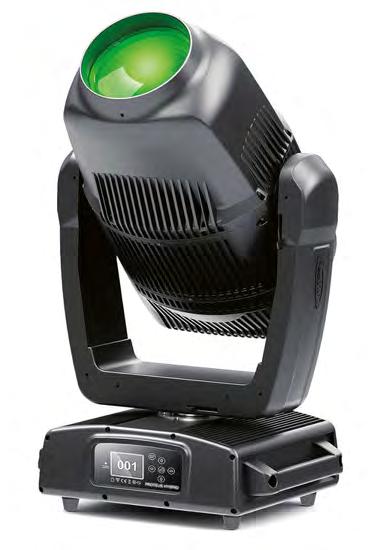
“We’re emulating that centre peakness of a lamp in some of our LED products already,” adds Dunn. “They have a high-centre-intensity white LED engine designed to create that parallel collimated beam with the pronounced centre. The ratio is not as pronounced as with a discharge lamp but they are very impressive at distances and a big step in the right direction. We are now reaping the advantages of both worlds with a new type of discharge lamp.”
We all know that LED is the future – and very much the present – but until an LED can pack more punch in a smaller space, discharge-based luminaires still have an important role to play in the house of worship and entertainment technology industries.
TECHNOLOGY 40 WORSHIP AVL March–April 2023
www.elationlighting.com
A look inside an ETC Source Four XT HID Elation’s Proteus Hybrid
The MAC Viper Performance from Martin
The choice is yours!
The Ultimate Key Light Profile that does it All!


KL PROFILE FC
The one light that does it all!
The ultimate in flexibility and performance
• Everything you need in ONE innovative package
• Full Color Spectrum (Color Mixing + Brilliant Whites)
• No need for additional lighting accessories
• Superior performance, easy to use
• Energy efficient and durable design


Traditional Profile and accessories
• The most convenient and cost-effective solution on the market
Whether you’re setting the mood for a special event or illuminating an on-stage performance, the all-in-one KL Profile FC is the perfect choice for any setting.
Contact us for your demo today at sales@elationlighting.com
www.ElationLighting.com
Make your worship streams more engaging with multiple sources
Magewell’s latest video capture and encoding solutions include the ability to combine multiple sources
THE FIRST LIVESTREAMING
efforts at many houses of worship started out with just a single video source, usually a live feed of the worship leader. This was particularly true in smaller churches, and with HOWs that embraced streaming for the first time during the pandemic and needed to get up and running quickly.
With streaming now so ubiquitous, though, it takes more than a single camera angle to keep viewers engaged. Live worship services and events that incorporate multiple video sources and other media are more compelling and hold audiences’ attention longer. However, adding an external video mixer or switcher to the streaming production workflow not only adds to equipment costs, but may also need an additional volunteer to operate it.
It’s with this in mind that Magewell’s newest video capture and encoding solutions for houses of worship include the ability to easily combine multiple sources.
Multi-input capture hardware for software-based streaming
Magewell’s single-input USB Capture devices have been extremely popular with houses of worship for bringing an AV signal into software-based production solutions. The new USB Fusion multi-input capture and mixing device offers the same outstanding ease of use while letting users combine camera and wired screenshare inputs into attractive presentations without needing additional switching or mixing tools. It is ideal for houses of worship that
wish to combine a camera signal with supporting visuals – such as lyrics displayed from a separate laptop – into a single livestream. Featuring two HDMI inputs and one USB webcam input, USB Fusion lets users switch between 1080p60 HD sources or combine two inputs (picture-in-picture or side-by-side) into one output. The result can be captured into popular Windows, Mac or Linux software via USB Fusion’s USB 3.0 interface. Standard UVC and UAC compatibility enables extensive software interoperability and an easy, driver-free setup. USB Fusion also offers an HDMI output for connection to a projector, display or downstream production equipment, making it equally adept as a standalone, tablet-controlled presentation device.
USB Fusion offers three ways for users to compose and control their
presentations. On-device buttons allow users to switch between sources or select a combined scene layout, while a browser-based web interface offers presentation management, scene switching, status monitoring and device configuration. The full presentation power of USB Fusion is unlocked through the free USB Fusion companion app for iOS and Android tablets, which provides expanded layout controls and lets users add pictures, video clips, background music, handwritten notes and more into their presentations. Playlists incorporating live video and other media can be set up in advance, and the combined output can be recorded onto the hardware’s builtin storage.
For more information about USB Fusion, visit www.magewell.com/ capture/usb-fusion
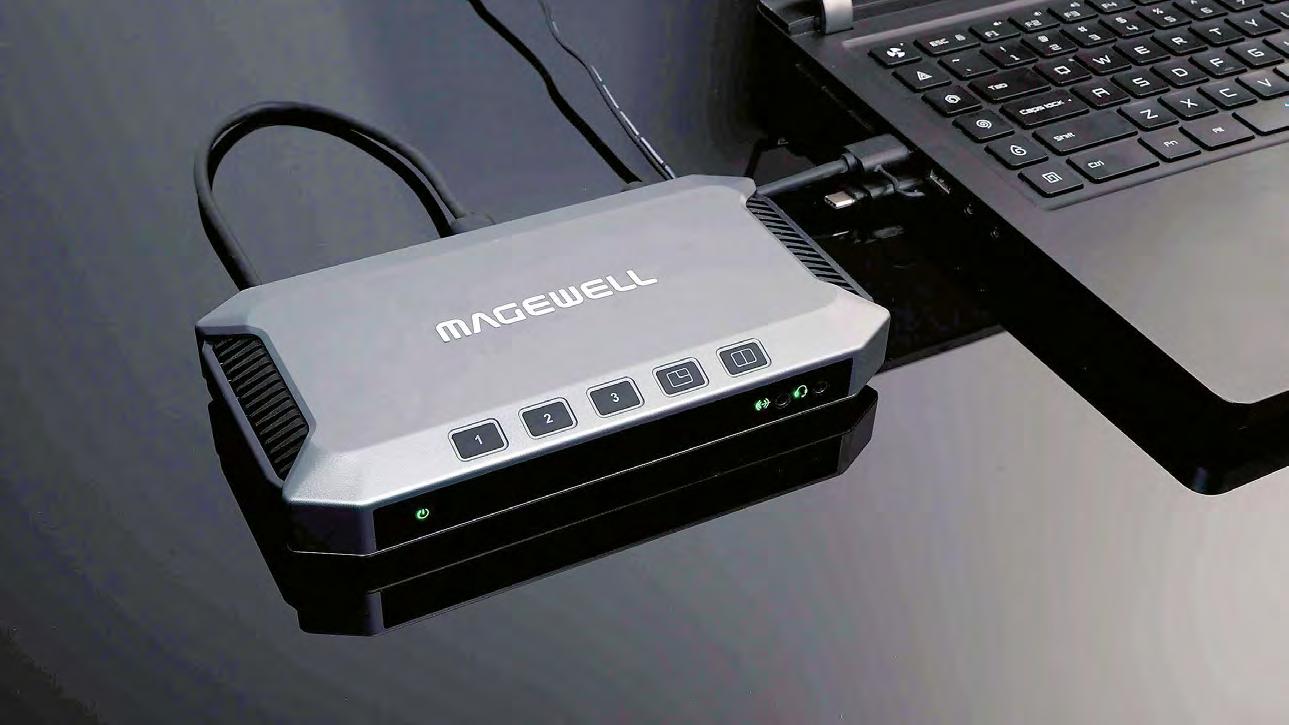
42 WORSHIP AVL March–April 2023
PRODUCT SPOTLIGHT SPONSORED BY www.magewell.com
USB Fusion
Standalone hardware-based encoding and streaming
While software-based streaming may offer the greatest production flexibility, some streaming producers or volunteers may prefer the simplicity and assured performance of a hardware-based encoding and streaming solution. For those users, Magewell’s new Ultra Encode AIO advanced live media encoders offer houses of worship a flexible encoding solution for applications ranging from livestreaming and multisite video distribution to IP-based production workflows.
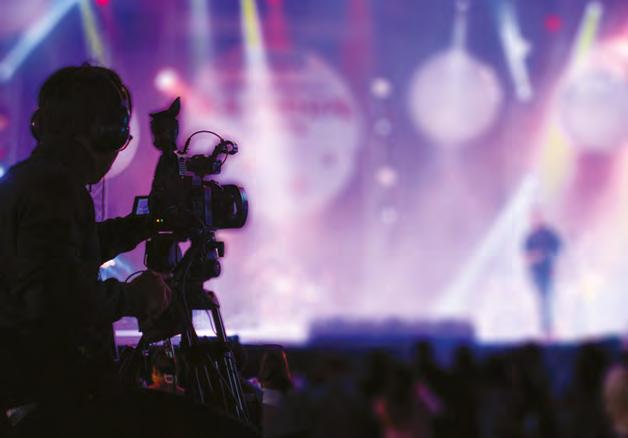
Ultra Encode AIO builds on the capabilities of Magewell’s original Ultra Encode family with expanded features, including HDMI and SDI input connectivity in a single unit; 4K (30fps) encoding and streaming from the HDMI input; simultaneous multi-protocol streaming; file recording; and much more. It can encode one live input source –either HDMI or SDI – or mix video
from the HDMI and SDI inputs (picture-in-picture or side-by-side) into a combined output.
Ultra Encode AIO supports H.264 and H.265 (HEVC) streaming in multiple protocols, including RTMP, SRT, HLS and more. Video can
be encoded at resolutions up to 4096x2160 at 30fps from HDMI sources or up to 1080p HD at 60fps from the device’s 3G-SDI input.

Configurable presets enable easy streaming to YouTube
Live, Facebook

Live, Twitch or custom targets.
Ultra Encode AIO can stream to up to six different target destinations simultaneously, including the ability to stream concurrently in multiple protocols. Inputs can also be recorded as files to an SD card, USB-connected storage device or networked storage. Up to eight user-configurable overlays – including text, images and a clock – can be applied to each encoding
For IP production workflows and AV-over-IP distribution architectures, Ultra Encode AIO supports NDI|HX 3, the latest version of the high-efficiency, lowbandwidth option in the popular NDI IP media transport technology platform. Ultra Encode AIO also supports the earlier NDI|HX 2 for broad compatibility.
For more information about Ultra Encode AIO, visit www.magewell. com/ultra-encode-aio
SPONSORED BY PRODUCT SPOTLIGHT
Everything you love about Dante Audio, now for video. audinate.com/dante-av
Ultra Encode AIO


A–ZCONTENTS
RCF launches line array system and companion

THE HL 6 from RCF is a two-way, fullrange system, most suited for when line array performance and a fast and easy setup are needed. The HL 6 features RCF transducers, two 6-inch woofers for a solid bass reproduction, plus a high-powered 1.75-inch voice coil compression driver mounted on a precise 100° x 10° waveguide to deliver vocal clarity with high definition and dynamics.
The HL 35-S is the flyable bass complement for the HL 6 array system. It features a Baltic birch plywood cabinet housing one 4-inch voice coil, a 15-inch neodymium woofer to handle frequencies from 40–140Hz with what is stated to be the maximum linearity and lowest distortion. The hardware is designed for an easy and fast setup, compatible with the HL 6 rigging. The heavy-duty front grille is powder coated. A special transparent-tosound foam backing inside helps to further protect the transducers from dust.
The SUB 8008-AS is a double 18-inch high-power active subwoofer. loys an RCF-designed transducer featuring a highpower ceramic magnetic circuit with a 4-inch voice coil. The power amplifier manages high currents for up to 4,400W, delivering sound pressure levels up to 137dB. Rear panel controls include 12 presets, crossover frequency, polarity switch, deep/punch selection, cardioid and output delay settings. The subwoofer is produced in a tour-ready, rugged, all-wood cabinet with a scratch-resistant polyurea
Primarily designed for midto long-throw applications demanding accurate speech and music reproduction, RCF has launched a compact, point source loudspeaker. The two-way Q 15 combines an RCF precision 15-inch neodymium woofer with an

ND940 4-inch voice coil and a 4-inch titanium-neodymium compression driver. Operating within a frequency range of 45Hz–20kHz (–10dB), the biamp module registers a 1,500W AES power rating that can produce a maximum output of 138dB SPL. Three variations of the Q 15 are available, offering varying vertical directivity in the form of the Q 15-P (40°), Q 15 (60°) or Q 15-L (90°) models.
In brief, the NXW 44-A is an active two-way column speaker by RCF designed for a range of users. Its combination of RCF transducers and a 2,100W two-channel Class-D amp produces coherent 100° x 50° coverage for the listening area up to 135dB SPL. Finally, the BT Board DMA can be paired with a DMA amplifier to provide Bluetooth connectivity on a mobile device. This makes is possible not only to send audio from a mobile device to the amplifier, but also control levels and EQ via an Android or iOS app.
www.rcf.it
March–April 2023 WORSHIP AVL 45
ADJ Jolt Panel FX /Jolt Bar FX 57 AJA ColorBox 54 Alcons Audio LR24/120 / LFE18sl 47 Analog Way LivePremier v3.0 52 Astera RuntimeExtender 57 Audac CEP408/CEP803 48 Audio-Technica AT2020USB-X 51 AV Stumpfl Monoly te 52 Ayrton Zonda 3 Wash and FX 55 Blackmagic Design Ultimatte 12 HD 53 Cameo P-Series 56 Clear- Com V-Series IrisX IP 54 DirectOut Prodigy update 50 Dynacord WPN1 51 Elation Proteus Excalibur Sky Motion 56 Electro-Voice EVERSE 8 46 Epson EB-PU1006W 52 Equipson Light Shark Ray 54 ETC ColorSource V 56 GLP Fusion X-PAR 12 Z 55 HH Electronics M-Series 48 High End Systems Halcyon 55 JBL PRX900 Series 46 KLOTZ AIS DMXV TrussLink Stagebox 50 KV2 Audio 500 Series/SL6.10 49 Leyard Luminate Ultra Series 51 Marshall Electronics CV420e 54 Martin Professional ELP PAR IP 55 Meyer Sound Milan version of Ultra-X20 46 Optimal Audio Cuboid 3, 3TX, 5 and 5TX 47 Pan Acoustics VESA Speaker Mount 47 Powersoft Duecanali 804 DSP+ 48 QSC AD-C6T-HC/AD-C6T-HP 46 RCF HL 6/HL 35-S 45 Robe TX1 PosiProfile 57 Sennheiser MKE Mini 50 Sommer C able Cardinal DVM 10G USB 3.2 48 NEWPRODUCTS AV • LIGHTING • LIVE SOUND • INSTALLATION • BROADCAST • RECORDING
subwoofer
manufacturer RCF has added
of speakers and subwoofers to
HL 6 Q 15
Italian
a selection
its growing portfolio
EV portability goes forward with EVERSE 8
DESIGNED FOR live music, vocal reinforcement and audio playback in a wide variety of applications, ElectroVoice has released the EVERSE 8 battery-powered loudspeaker. The portable, wireless enclosure can be remotely controlled via the QuickSmart Mobile app and Bluetooth.
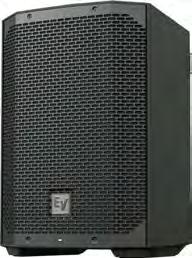
Combining a maximum SPL rating of 121dB with even 100° x 100° coverage, EVERSE 8 comprises an 8-inch woofer mounted using EV’s Signal Synchronized Transducers (SST) port design, and a titanium tweeter mounted onto a constantdirectivity waveguide. Housed in a weatherised black or white polypropylene enclosure, the 8-inch model is driven by a Class-D amplifier and DSP module developed by Dynacord. A built-in four-channel digital mixer with studio-quality
effects, feedback suppression and audio ducking are included.
Fully optimised to provide 12 hours of continuous audio operation, EVERSE 8 is powered by a high-capacity Li-ion battery pack. Protection circuitry reduces the risk of the battery discharging to such a low voltage that it can no longer be recharged, including long periods in storage.
The EVERSE 8’s flexible features encourage an input to output selfcontained setup. Wireless control and monitoring performed from the EV QuickSmart Mobile app includes adjustments to the audio, effects and mix functions via phone or tablet. An integrated 12V DC port connecting the EVERSE 8 battery promotes its use with RE3 or R300 wireless microphone receivers by attaching the optional accessory tray to the enclosure for securing the receiver hardware.
Integrating an IP43-rated weatherised input cover, rubber feet and a soft-touch handle, the ergonomically polypropylene enclosure can be mounted on a tripod, deployed as a stage wedge using the 55° monitor angle or positioned upright with the 30° kick-back angle.
www.electrovoice.com
JBL debuts next-generation portable systems
JBL HAS introduced the PRX900 Series, comprising three powered two-way loudspeakers and two powered subwoofers, built from the ground up to leverage its latest acoustic innovations. A new proprietary driver system, powered by Class-D amplifiers, is combined with improved dispersion and beam width as well as complete Bluetooth Low Energy (BLE) control via the JBL Pro Connect app.

The series integrates JBL’s patented 2408H-2 1.5-inch compression drivers with poly-annular diaphragms and neodymium magnets which are paired with updated JBL Image Control Waveguides to deliver consistent beamwidth and frequency dispersion. An FEA flared port design for the woofers reportedly reduces air noise and distortion. Producing up to 134dB down to 30Hz, the series can support large performance spaces with high power and performance requirements.
Accessible via onboard LCDs and the Pro Connect app, the PRX900 Series’ integrated DSP includes 12-band parametric EQ for system tuning and tonal control, as well as integrated dbx Drive Rack technology featuring live and fixed Automatic Feedback Suppression with Soundcraft’s Overeasy option and speaker delay settings and presets. The rigid composite loudspeaker cabinets feature computer-modelled ribbing for optimal acoustic performance and durability, while the subwoofers are housed in 18mm birch cabinets with optimised bracing for accurate lowfrequency response.
The JBL Pro Connect app can be used to control up to 10 speakers as well as integrate the PRX900 with JBL EON ONE MK2, PRX ONE and EON700 systems to access app-only functions such as speaker snapshots and grouping.
pro.harman.com
Meyer Sound expands Milan-certified speaker range
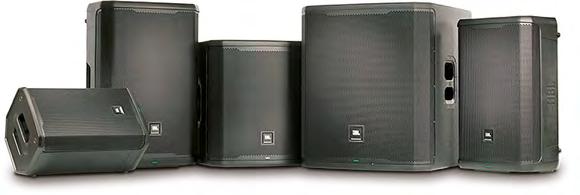
MEYER SOUND has added three loudspeakers and a subwoofer as standalone endpoints for direct connection to any AVB network compliant with the Milan interoperability protocol. The Milan input versions of the Ultra-X20, Ultra-X22 and Ultra-X23 full-range loudspeakers and the USW-112P compact subwoofer accept audio signals from any Milan-certified source via a certified switch. A single RJ45 connector carries high-
resolution digital audio in addition to telemetry data for remote monitoring. The availability of Milan-certified loudspeaker systems enables complete network AV solutions that offer simplified management and control in addition to a more cost-effective installation using IT industry infrastructures. Network solutions also maintain a fully digital workflow to the endpoint, eliminating conversion stages that add latency and degrade performance. All four
QSC expands AcousticDesign portfolio
THE ACOUSTICDESIGN Series of loudspeakers has been extended with the development of two 6.5-inch two-way ceiling-mount models. The AD-C6T-HC has been designed to offer higher-power handling in challenging environments, while the AD-C6T-HP offers higher SPL at standard ceiling heights. Distinguished by a slim,

models incorporate Milan-certified input modules together with a Neutrik etherCON TOP network connector and a powerCON TOP AC line connector for weatherresistant connections. Remote monitoring capability is also included and utilises the common network connection rather than separate wiring.
www.avnu.org
www.meyersound.com
aesthetic design, both models provide consistent tonal quality within the AcousticDesign portfolio. In addition to the blind mounting, SIs can adopt Q-SYS Intrinsic Correction when tuning with custom Q-SYS loudspeaker voicings via the Q-SYS platform
www.qsc.com

46 WORSHIP AVL March–April 2023 PRODUCTS
and AD-C6T-HP
AD-C6T-HC
USW-112P
Cuboid Series gets even more Optimal
OPTIMAL AUDIO has announced new additions to its Cuboid line-up of loudspeakers, with four models unveiled available in either black or white. The new cabinets consist of the Cuboid 3, Cuboid 3TX, Cuboid 5 and Cuboid 5TX.
The Cuboid 3 is a full-range, twoway, passive 3-inch loudspeaker designed to give superior sound quality in a very small form factor for distributed applications with high-quality background music and
speech reproduction. Included mounting hardware allows for fixing in either portrait or landscape orientation for installation flexibility. A weatherproof terminal cover is available as an aftermarket accessory for outdoor use, giving the cabinet an IP54 rating. It features a 3.5-inch low-frequency driver and a 0.5-inch PEI dome high-frequency driver mated to a shallow waveguide for consistent HF distribution.
transformer that enables the speakers to run on a series of 70V or 100V taps or at low impedance. Tap selection is via a rotary switch on the rear of the cabinet. The Cuboid 5 and
Alcons Audio provides extra backup
facilitates both compressed and non-compressed suspension, while enabling angle-setting on the cabinets without lifting the array. It has a WLL of 24 cabinets under 10:1 safety.
but instead feature a 5.25-inch low-frequency driver and a 0.75-inch HF driver.
www.optimal-audio.co.uk
Pan Acoustics adds VESA mount
LR24/120
HAVING BUILT up its L-series of pro-ribbon line array modules into a comprehensive range to bring hi-fi sound quality to any size venue, Alcons Audio has released the LR24/120 mid-size array, intended to be an important extra tool for medium and larger applications. The LR24/120 is designed to complement the narrower dispersion, longer throw of the LR24/90.

The three-way, bi-amped LR24/120 features the bespoke RBN1202rs 12-inch pro-ribbon transducer with acoustically and electronically symmetrical component configuration, delivering a natural cylindrical wavefront with pattern control in both the vertical and horizontal plane. Thanks to the RBN1202’s power handling of 2,500W, enabled by its 12-inch voice coil and an RMS-to-peak ratio of 1:15 from 1kHz–20kHz, high intelligibility is complemented by dynamic headroom reserve.
The pro-ribbon driver is bolstered by a mid-frequency section comprising two 6.5-inch midrange transducers with a neodymium motor structure. The low-frequency
section features new-generation 12-inch transducers, fitted with a large, dual 3.5-inch voice coil neodymium motor. As with all L-series systems, this is assisted by Signal Integrity Sensing (SIS) prewiring. This circuit ensures dynamic cable/connector compensation between the LR24/120 and the Sentinel amplified loudspeaker controller which powers it, providing undistorted, natural sound reproduction regardless of cable length and amplifier impedance load. The flying system
Alcons has also introduced its LFE18sl subwoofer, a slim-sized reference subwoofer system for demanding listening applications, delivering an accurate bass and sub response for “a maximum quality aural and sensory performance”. The manufacturer has focused on obtaining a linear response in the operating bandwidth, while handling ultra-low-frequency transients with maximum control.
The 18-inch custom-designed woofer features a large motor structure with dual 3-inch voice coils offering a 30mm excursion, reportedly resulting in 10dB more excursion than a traditional (pro) 18-inch woofer. The direct-radiating transducer mounted in the sealed cabinet enables an in-room response below 10Hz. The driver is pre-wired for the Signal Integrity Sensing (SIS) compensating circuit which claims to deliver an accurate reproduction for even the lowest octaves.

In brief, Alcons’ proprietary ALC software program, ALControl, has been upgraded to v1.72. The update includes support for the different device startup modes (standby, on, previous) and for displaying the AES/EBU sample rate input of the Sentinel.
PAN ACOUSTICS has extended its Pan Accessories series with the VESA Speaker Mount. The mount allows an “uncomplicated and quick installation” of Pan Acoustics line source speakers
LFE18sl
www.alconsaudio.com

on all common displays. The VESA Speaker Mount is mounted as an adapter between the display and the existing VESA mount. The smaller VSM model is suitable for use on displays measuring 55–65 inches, while the larger VSM XL variant can be used on 75- to 98-inch displays. The mount consists of just a few parts and is designed so that the speakers can be mounted and aligned precisely with the frame of the display and flush-mount with the display front.
www.pan-acoustics.de

March–April 2023 WORSHIP AVL 47 PRODUCTS
HH Electronics extends its power with M-Series
DESIGNED FOR both fixed and live music applications that require high-fidelity audio and high power specifications, HH Electronics has launched the M-Series of 2U rack amplifiers. The M-750D, M-1500D
and M-2600D models comprise a Class-H toroidal power supply, linear power stage and comprehensive protection system.
Featuring balanced XLR inputs, userselectable input sensitivity, speakON
Audac doubles up with multichannel amps
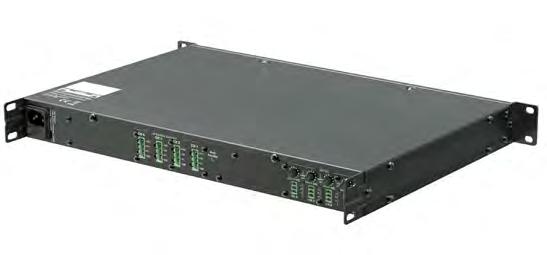
AUDAC HAS introduced two amplifiers with multiple channel outputs: the CEP408 quad-channel amp and CEP803 octo-channel amp. At 1U high, both units are compact and lightweight and are designed to offer low impedance at 70V/100V. Audac reports the units deliver Class-D amplifier technology which can be distributed over multiple zones in various applications, while miniature rear-mounted switches provide the ability to daisy-chain
Input connections are performed with three-pin terminal block connectors, with output connections via a four-pin terminal block connector. The CEP408 offers four channels and has an output power of 80W, while the CEP803 offers eight channels and has an output power of 30W. Both are Energy Star-compliant, which can be enabled or disabled with a standby switch on the rear of the device.
M-750D
connectors, binding post outputs, status indicators and comprehensive protection circuits, the three amplifiers weigh between 12.5kg and 24.2kg. Incorporating power, input sensitivity and bridge/
routing mode switches, the two-channel models also feature volume controls on both channels. Equipped with soft start, VHF, RF, short circuit, overload, clip limit and overheat protections, the M-750D, M-1500D and M-2600D amplifiers output 2x750W, 2x1,500W and 2x2,600W, respectively.
www.hhelectronics.com
amplifier line-up
POWERSOFT HAS further enhanced its fixed-install product range by introducing AES67-compatible versions of its Duecanali and Quattrocanali amplifier platforms. The new models, called Duecanali DSP+ and Quattrocanali DSP+, are able to receive audio-over-IP (AoIP) streams compliant with the AES67 standard, allowing for high-performance streaming AoIP interoperability across different networking systems.
CEP408
The new DSP+ models (Duecanali 804 DSP+, 1604 DSP+, 4804 DSP+ and 6404 DSP+ and


Quattrocanali 1204 DSP+, 2404 DSP+, 4804 DSP+ and 8804 DSP+) can receive AES67 streams natively by connecting the dedicated AoIP networking port to an AES67 network. The new DSP+ amplifiers are supported by a new version of ArmoníaPlus, the Italian manufacturer’s system design, control and monitoring software. All Powersoft amplifiers featuring a Dante card can also be configured to work with AES67 audio streams by enabling AES67 mode in ArmoníaPlus or Dante Controller.
www.powersoft.com
SOMMER CABLE has created a well-conceived product line around the latest USB-C connection. Under its own Cardinal DVM brand, a 10G USB 3.2 hub has been conceived as a clip-in module for the SYSWALL-45 switch frame series that fits within SYSFRAME45 installation frames and SYSTRUNK duct profiles in addition to other common 45mm connection units.
Available in matt white, high-gloss white, charcoal grey and silver finishes, the four connections with 10G bandwidth are available as dual USB Type-A and dual USB Type-C ports on the front side which also deliver 30W of charging power for connected terminal equipment. A USB Type-C upstream port is located on the rear with an additional power supply connector.

The DVM-194-PS5 USB-C power supply relies on GaN technology for fast, simultaneous charging of multiple USB-C and USB-A devices
85W system distributes power smartly across dual USB-A and dual USB-C connections for various charging standards and power supplies. The compact design and the detachable AC cable promotes the unit to be integrated discreetly behind connection panels.
Offering a maximum charging power of 100W and a data transfer rate of 20Gbit/s, the HI-U3CC USB 3.2x2 cable series is characterised by a nylon/cotton fabric textile cover
fully extruded USB connectors are built into the aluminium housing and E-marker chips within the USB-C connector communicate with the connected devices to avoid overloads. The series includes 10Gbit/s USB-A – USB-C (HI-U3AC) and USB-A – USB-A versions (HI-U3AA) together with matching extension cables (HI-U3CF) which can be optionally used with a clip-in Keystone housing in white or black for permanent installation.
Supporting 10Gbit/s USB 3.2 signals and combined with 4K60 video signals with 60W of charging power, the 6mm-diameter HI-UAOC series provides reliable transmission for USB-C cable lengths over 2m. The manufacturer has also added the 580-0802FC to its expanding range of Cat8.1 network cables. With an overall diameter of 8.2mm and an AWG22/1 cross-section (0.62mm), the halogen-free LSZH jacket meets IEC 60332-1-2, IEC 60754-1/2 and IEC 61034-1/2 standards and is flame retardant with a B2ca high fire protection classification. Supporting a transmission frequency of up to 2,000MHz in addition to a data rate of up to 40Gbit/s, the cable is suitable for high-speed Ethernet network connections between routers and switches in building infrastructure.
www.sommercable.com
48 WORSHIP AVL March–April 2023 PRODUCTS
Sommer makes a connection
KV2 Audio introduces 500 Series processors
KV2 AUDIO has launched the 500 Series range of audio processors, a series of “ultra-high-quality” processors consisting of three models. The TCL is described as a unique analogue thermo audio compressor featuring a superior natural RMS detector and dynamic voice bass enhancement control. According to the manufacturer, its patented design offers an exceptionally musical and natural compression that is a component part of its real-time input, as opposed

PROFESSIONAL TO THE CORE
addition of the SL6.10 subwoofer, a replacement for the SL2.15. Measuring 350mm deep and designed to integrate aesthetically with the manufacturer’s SL412, the SL6.10 is described as producing “powerful, accurate bass” from its slim cabinet design and is suitable for full-range music playback in fixed installations and multi-use venues. Bass response is further enhanced by doubling, or even tripling the cabinets, particularly when the SL6.10 is used against or within a
DELIVERING BUSINESS
Source high-end PA systems, Live Sound & Display. Since 2 decades, PALM Expo is the only platform that provides solutions for System Integrators & Sound Contractors. www.palmexpo.in

PRODUCTS
ramesh.chetwani@hyve.group For Booth Bookings, Feature Participation and Sponsorship, contact
soundlightaudiovisual
BOMBAY
500 Series
25 - 27.05.2023
EXHIBITION CENTRE, GOREGAON (E), MUMBAI, INDIA
Upgrade brings automation to DirectOut’s Prodigy
AN UPGRADE to DirectOut’s Prodigy series has introduced the availability of an Automater License for Prodigy.MC convertors and Prodigy.MP audio processors. Automator allows for the ability to program triggers in order to run tasks in an automated fashion. Triggers can be from different sources, such as parameter or status changes in the device itself, a MIDI or OSC command from an external device, a cron job (periodically
recurring trigger) or can be created based on time. Device actions such as gains, mutes, snapshot recalls, input manager switches and EARS source selection or GPOs can also be triggered, and it is possible to send custom-defined messages via OSC and MIDI, or to hosts via HTTP, UDP or TCP commands.
In addition to this, the manufacturer’s Disaster Recovery solution – a component of its EARS
feature – has been made more secure. For the Prodigy series, a solution with a third multichannel audio source has been implemented, which is automatically selected in case the main and backup multichannel input (MADI or audio network) fail.
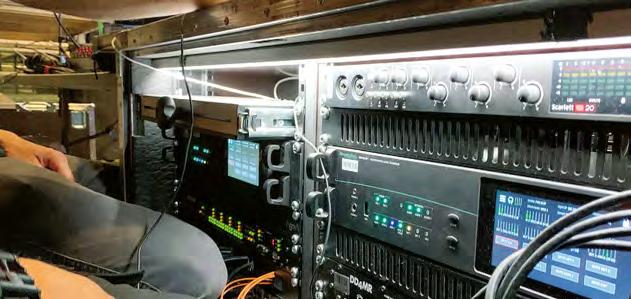
Further features have been added to the series as a whole, such as configurable crossfades for groups, as well as the automatic four-wire patch function for the Routing tab. For the Prodigy.MP specifically, a new IIR filter has been implemented – the First Order All Pass for Live Sound –which allows for phase rotation of 90° at selected frequencies. A newly added Solo Bus function makes it possible to route soloed channels to the Prodigy.MP’s summing busses 31/32. There are three modes of the feature: summing all soloed channels; replacing, where one soloed channel replaces the previously selected one; and a PA tuning mode, where the processed and clean signal is routed to the solo bus outputs automatically.
www.directout.eu
KLOTZ releases DMXV series for combined audio/DMX stageboxes
THE DMXV TrussLink Stagebox series by KLOTZ has been designed for when audio signals and DMX signals have to be combined via a stagebox in professional use. The DMXV’s lightweight but robust aluminium housing is powder-coated black and features abrasion-resistant laser engraving. It accommodates eight
Sennheiser unveils “quick and easy” presenter mic
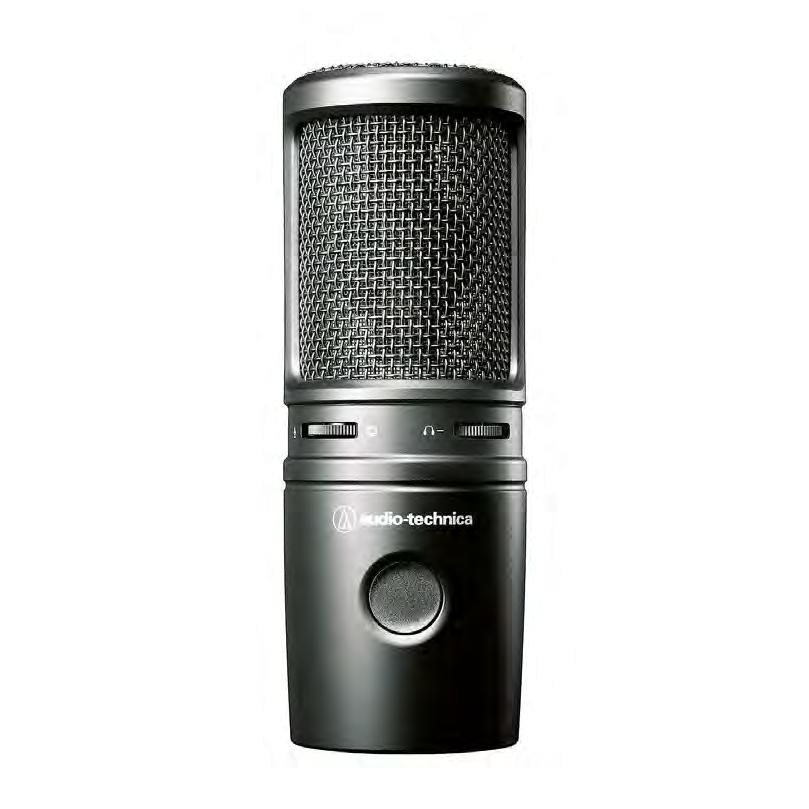
or 12 channels with RMP multipin connectors to the MIL-C-5015 standard. The paired Neutrik XLR 5p chassis jacks with hard gold-plated contacts can be used as either inputs or outputs. Flexibility is offered by the 12-channel DMXV-04FM version, which provides eight channels with XLR 5p and four channels with XLR 3p sockets. In addition to the eight DMX channels via XLR 5p, four channels can also be used for DMX via XLR 3p, AES/EBU or analogue microphone and line audio signals.

TrussLink stageboxes in the DMXV series can be used both on the floor and in the rig. For this purpose, the housing is equipped with non-slip rubber feet, an M10 thread on the bottom and four eyelets for safety ropes.

The manufacturer has also introduced two digital cable
drums using Neutrik XLR 3p and 5p connectors and protective caps which both use KLOTZ’s OT234YS low-loss data cable. With a conductor cross-section of 0.34mm² (AWG 22/7), the company reports the cable has a particularly low signal attenuation which makes it suitable for long distances and is capable of transmitting both digital and analogue signals. Two shields protect against noise: one is Al-PET foil and the second is a dense copper braiding with a coverage of 85%. The PVC jacket has an outer diameter of 6.7mm and can withstand a temperature range of –20°C to +70°C.
Despite the level of conductor crosssection and double shielding, cable flexibility provides a minimum bend radius of 40mm, which makes the OT234YS suitable for cable drums.
The AES3N4YSD and DMX5N4YSD cable drums are made of breakresistant plastic and are equipped with a locking brake. At the outer reel core, the cable end is available in a length of 2m. Both cable ends are also provided with transparent shrink tubes for labelling. The cable drums are available in lengths from 50–200m.

www.klotz-ais.com
A NEW no-fuss lavalier microphone has been unveiled by German manufacturer Sennheiser. Described as a highquality, miniature omnidirectional model, the MKE Mini measures 9cm in length and is ultra-light at 7g. Developed in response to easy to install, the MKE Mini can be used when a hairstyle doesn’t allow for a head mic or when wearing an outfit that offers no possibility to clip a bodypack. All that is needed for setup is to connect the microphone to a bodypack and attach a lanyard.
Housed within the MKE Mini is the same KE 4 capsule derived from Sennheiser’s MKE 2 microphone, with improvements made to provide “a warm and distortion-free signal”, even at high sound pressure levels.
www.sennheiser.com
50 WORSHIP AVL March–April 2023 PRODUCTS
DMXV TrussLink Stagebox
AES3N4YSD
Leyard illuminates the outdoors
THE LUMINATE Ultra Series LED videowall display has been added to Leyard’s portfolio of outdoor display solutions. Designed for signage and other large venue facilities, the fine pitch outdoor LED display is designed for up-close viewing in high-ambient light environments.
With coated LEDs for ruggedness and image detail, the Luminate Ultra Series provides nearly 140° visibility and is designed to enhance viewing angles with limited interference, even in direct sunlight. With models in 1.5mm and 1.9mm pixel pitches and up to 3,500 nits of brightness, it supports viewing from as close as 1.8m.
Supporting wall-mounted, corner, convex and concave installations, and with full front and rear installation and service, the display is said to be flexible enough to create a videowall of nearly any size. It features an IP65 Ingress Protection Rating to withstand weather conditions, dust and
water. The displays also include a protective coating that fills the gaps between LEDs which strengthens weather protection and increases visual contrast for deeper black levels.
Audio-Technica releases upgraded AT2020USB

The second-generation of Leyard’s Black Diamond series has also been launched, introducing new Micro LED display technology for pixel pitches above 0.9mm for the first time. The company’s Nin1 Micro LED technology


continues to serve products with pixel pitches below 1mm. The new Black Diamond series uses flip-chip technology that reportedly results in higher stability and reliability than previous SMD LEDs, together with three times the contrast ratio and twice the brightness. The result is uniform light distribution with lower power consumption. The Black Diamond series makes use of a common cathode driver IC and ASIC display control chip with independent intellectual property rights which results in a 27% power consumption reduction compared to a common anode driver design when running at 600–800-nit brightness. It’s also capable of 2,000-nit peak brightness at peak power consumption. Advanced image processing technology is also reportedly capable of achieving 100% of the DCI-P3 colour gamut with twice the colour purity.
sz.leyard.com
Dynacord expands the Sonicue ecosystem
WITH THE introduction of the networked WPN1 controller and version 1.2.4 of Sonicue sound system software, Dynacord aims to simplify audio system setup and control. Featuring a 45mm colour TFT display and a single-knob encoder, the WPN1 is a compact wall panel controller that allows personnel to adjust the volume, select the source and mute, in addition to other system functions. Shipping with interchangeable white and black front covers, the PoE-powered device is available for both EU and US standard wall-mount boxes. Networked and connected to Dynacord’s MXE5 matrix mix engine, a 24x24 performance audio matrix is created offering control, routing and mixing functionalities. Serving as a control server, the MXE5’s system logic enables the WPN1 to control one or multiple audio zones, as well as other peripherals such as lights, projectors or blinds.

Unicode character support allows the systems designer to label controls on the display in local languages. Multi-PIN protection and screensaver options can be configured via the panel designer within the Sonicue sound system software.
In addition to supporting the WPN1 wall panel controller, the v1.2.4 Sonicue software update enhances the system logic of the MXE5 by
adding an active HTTP Application Programming Interface (API) to actively control third-party devices. Furthermore, a scheduler function for recurring events turns the MXE5 from an audio processor into a system control centre. Bypassing the need for an MXE5 control panel, support has been implemented to monitor and control the TGX and IPX amplifiers on PC and iOS devices or via a TPC-1 touch panel controller. Parameters including level, mute, preset and recall, as well as status flags and VU metering, can now be used to create custom control panels.
www.dynacord.com
March–April 2023 WORSHIP AVL 51 PRODUCTS
A REIMAGINING of the popular AT2020USB+, the AT2020USB-X
24-bit/96kHz sample rate and USB-C connectivity.
Luminate Ultra
Setting up in a snap with Monolyte
MONOLYTE IS a unibody screen system from AV Stumpfl designed for use in small venues. Its extruded aluminium profiles and snap joints define the skeleton of the projection screen, while it boasts an entire frame block that unfolds and locks automatically. According to the company, this means the system can

be constructed in less than three minutes and without the need for additional tools. It is available in two screen sizes: 218cm x 123cm and 266cm x 150cm. An optional skirt can be mounted at the bottom to disguise the integral legs.
www.avstumpfl.com
3D LUTs now available for LivePremier
ANALOG WAY has introduced a suite of new features with the v3.0 software release for its LivePremier 4K/8K multi-screen presentation systems, including video processing architecture based on 3D Lookup Tables (LUTs). In addition to advanced colour management with predefined and custom external 3D LUTs, the upgrade enables optimised layer resource management and the ability to clone any programme output to another physical output.
Once updated, the Aquilon image processor will contain predefined LUTs for all automatic adjustments and conversions. Additionally, it will be possible to import and apply custom 3D LUTs from other vendors or generated by third-party tools.
Three types of 3D LUTs are supported: conversion LUTs intended for advanced colour space and dynamic range conversions; correction LUTs for advanced colour corrections on inputs or outputs; and 3D CremaTTe LUTs to perform advanced input keying using Analog Way’s dedicated 3D CremaTTe tool.
With v3.0, layer resources available on large screens are significantly optimised using regions and captive PIPs. This is particularly useful for applications that require the display of a large number of sources simultaneously and that do not need to have layers spread out over the entire pixel canvas.
Additionally, Analog Way has announced software release 3.5 for its Picturall media servers. The update integrates Softpix’s SPX real-time graphics solution and supports VIOSO
camera-based projector calibration to enable new applications, including panoramic cylinder projections or projection domes. The release follows the partnership agreements recently signed with Softpix, provider of graphics software and creative services, as well as with VIOSO. The integration of Softpix’s SPX real-time graphics solution into Analog Way’s Picturall series allows customers to show and edit graphics and text on both live shows and fixed installations.
SPX integration comes with a special template pack consisting of 10 templates, including name straps, news tickers, countdown clocks, sponsor carousels and other essential graphics. The templates’ colours and fonts can be themed with CSS style sheets, so they can act as a resource for any production. Customisation is possible for specific projects and complex interactions with thirdparty systems. The integration of VIOSO calibration tools allows for support of complex multi-projector installations and automatic recalibration of projector alignment using one or more remotely controlled cameras. Combined with the power of the Picturall media servers and their ability to reliably play back video content, it will be possible to drive 360° projection domes or complex panoramic cylinder projections from a single media server.
www.analogway.com
Brilliance and versatility delivered by Epson PU-series
ENGINEERED TO deliver bright, true-to-life images ranging from 6,000–10,000 lumens within digital signage applications, Epson has launched a new suite of high brightness laser projectors. Equipped with 3LCD technology, the EB-PU1006W, EB-PU1007W, EB-PU1008B and EB-PU2010B models faithfully reproduce colour without a rainbow effect. Integrating a high contrast ratio and a 4K enhancement feature, the projectors support HDR10 and Hybrid Log-Gamma for precise detailing for light and dark graduation contents. Outputting in 1920x1200 resolution, the lightweight four-in-one PU projectors are equipped with a laser

light source that provides up to 20,000 hours of maintenance-free usage.
Working with the Epson Projector Config Tool, the Near Field Communication (NFC) function provides a check on projector information, completes a diagnosis, configures the network and changes projection settings. Designed to enhance the process efficiencies of up to 100 projectors, the

management function can operate when the projector is switched off by placing an NFC-compatible smartphone over the NFC mark. Easier integration with existing systems is promoted with the Open Web API that implements commands that control the projectors.
The Epson PU-series units accept
curved and corner spaces in addition to borderless multi-directional projections with 360° rotation without any loss in image brightness. Adjustments to position, brightness and colour can be applied with the motorised lens shift and wider lens shift range. The wider lens shift range together with a stepping motor ensure precise adjustments when employing projection techniques, such as edge blending and stacking. Ceiling-mounted projectors can be adjusted via remote control or over a network – the optional ELPFP15 suspension adapter can be attached to the ELPMB67 mount. www.epson.com.sg

52 WORSHIP AVL March–April 2023 PRODUCTS
EB-PU1006W
PU2200 Series
Aquilon
Ultimatte 12 wizardry conjured by Blackmagic Design
WITH THE addition of four Ultimatte 12 real-time compositing processors, Blackmagic Design claims to have created the next generation of broadcast graphics. The lower-cost Ultimatte 12 HD, Ultimatte 12 4K and Ultimatte 12 8K models retain the same processing for edge handling, greater colour separation, colour fidelity and improved spill suppression. They model the television standard they are using. The Ultimatte 12 HD Mini model with HDMI connections allows ATEM Mini users to benefit from broadcast-quality keying when building innovative fixed-camera virtual sets. Eliminating the cost of external equipment, all Ultimatte 12 models incorporate built-in frame stores for keying using stills for backgrounds.

Retaining the same image processing algorithms and internal colour space, all four models produce identical quality compositions. Sub pixel processing automatically generates internal mattes, ensuring different parts of the image are processed separately based on the
colours in each area. Particularly useful for live production scenarios, Ultimatte 12 models feature one-touch keying technology that analyses a scene and automatically sets over 100 parameters.
The improved flare algorithms remove green tinting and spill to reportedly create realisticlooking virtual environments. With the elimination of shadows or transparent objects with reflections, the Ultimatte 12 units automatically


sample the colours and create seamless mattes for walls, floors and other parts of the image, before applying the necessary corrections.
The 4K and 8K models feature advanced 12G-SDI connections for operation with current HD formats, in addition to future Ultra HD and 8K video formats. The Ultimatte 12 HD Mini model allows conversion of SDI camera control to HDMI, ensuring an ATEM SDI switcher can control an HDMI-connected Blackmagic Pocket
Cinema Camera. The Ultimatte 12 HD can translate SDI to HDMI for the cameras as all ATEM switchers transmit camera control over SDI. All Ultimatte 12 units include free Ultimatte Software Control.
An update to Blackmagic Design’s DaVinci Resolve software has also been announced, featuring support for editing in vertical resolutions as well as automatic locking of individual timelines within bins for multi-user collaboration. DaVinci Resolve 18.1 also makes projects imported from ATEM Mini ISO projects easier to edit for customers, with audio now attaching to the video clips. DaVinci Resolve for iPad has also been unveiled, designed for creators “to extend video workflows in new ways and new places”. Optimised for MultiTouch technology and Apple Pencil, DaVinci Resolve for iPad features support for cut and colour pages, providing access to DaVinci’s image technology, colour-finishing tools and latest HDR workflows.

www.blackmagicdesign.com


March–April 2023 WORSHIP AVL 53 PRODUCTS
Pro Audiovisual & Entertainment Lighting Technologies Exhibition and Conference for the Growing Southeast Asia Markets www.prointegrationfuture.asia/ @Pro Integration Future Asia Connect with Us: Marina Bay Sands Expo & Convention Centre 26 to 28 June 2023 Monday to Wednesday Pro Integration Future Asia 2023 (PIFA2023) is an inaugural international trade show crafted for audiovisual and entertainment lighting suppliers and specialists to deliver real-world application showcases to multiple vertical markets in Southeast Asia. MARK THE DATES TODAY Join PIFA2023 to discover the boundless possibilities in the development of this ever-changing industry and engage the industry professionals, government agencies and start-ups Meet over 6,000 brands and integrators showcasing advanced AVL technologies Discover more than 100 key vertical markets such as education, enterprises and more! Connect with communities from 15
18.1 adds support for social media vertical resolutions
DaVinci Resolve
AJA unveils ColorBox for colour accuracy
WITH THE release of ColorBox, AJA has unveiled a portable device with inline algorithmic colour transforms and LUT processing capabilities for delivering accurate colour space conversions for live broadcast, live events, on-set production and postproduction. ColorBox enables a range of HDR and SDR conversions and allows DITs to load, modify and save looks, in addition to creating reference images for dailies to ensure colour accuracy across all production and creative personnel.
Designed to support a wide range of tasks on-set and in live production environments, ColorBox incorporates high-density 4K/ Ultra HD processing together with 12G-SDI and HDMI 2.0 outputs for local monitoring up to 4K/UHD video


and 30p 12-bit RGB 4:4:4 signal support. ColorBox includes AJA Color Pipeline (ACP) Mode with a 33-point 3D LUT processor with tetrahedral LUT interpolation, four built-in userconfigurable 1D LUTs and two 3x3 user-configurable matrices.
A USB OTG port and third-party Wi-Fi adapter provides wireless access to the web UI when a wired Ethernet connection is not available. Controlled via an integrated web browser-based interface, other features include a built-in RGB colour corrector and ProcAmp, LUT, matrices and image libraries, capture and recall capabilities together with ancillary (ANC) metadata management.
www.aja.com
LightShark Ray provides extra bite for Equipson
LIGHTSHARK RAY is a visualisation tool from Spanish manufacturer Equipson which allows users to experiment with multiple lighting setups using preconfigured files and fixtures. Originally developed as a training aid, the application is intended to be used with DMX-based LightShark lighting consoles.
LightShark Ray features up to 16 DMX universes across Art-Net or sACN, as well as built-in fixture and object libraries. The company plans to add GDTF libraries to future releases. Available for PC with a macOS version in development, LightShark Ray can receive video from a built-in NDI input, which not only allows
Clear-Com V-Series IrisX Panel shines brighter

COMBINING THIN-FILMtransistor (TFT) displays for increased brightness and better
higher resolution and increased variation in brightness for clearer label information and
the streaming of video files but also makes it possible to capture images from external cameras. Users can record visualisations with the integral screen recorder and can customise visualisation experiences with configurable parameters, such as smoke density and wind speed. Render quality is automatically adapted according to the computer capabilities of the end user, and the number of fps can be displayed. LightShark Ray offers fixed scenarios, but the company is aiming to have a scenarios editor available by summer that will join the platform.
www.equipson.es

several redundancy measures including N+1 card and network redundancy. Additional benefits include capacity for three concurrent full-duplex uncompressed audio streams and backwards compatibility with MVX-A16 and IVC-32 cards. Whether the application is in the dark or in direct sunlight at an outdoor event, the upgraded TFT displays in the IrisX enable
combined with just a single E-IPA card, and less than 10ms audio latency from the IrisX panel to frame via an AES67 connection. Ideal for public internet applications, three different connection options are supported with a direct four-wire, AES67 or the Clear-Com’s IV-Core protocol.
www.clearcom.com
Marshall redesigns the traditional PTZ
DESIGNED PRIMARILY for professional broadcast and pro AV applications and a range of AV installations requiring a high-quality networkable video source, Marshall has developed the CV420e ePTZ camera. Having removed the robotic movement of a traditional PTZ, the CV420e boasts ePTZ functionality that simulates digital pan, tilt and zoom operations within a larger 4K resolution pixel space. Operators can maintain access to wide angles in addition to useable digital zoom and lateral manoeuvres within the sensor.
Featuring a high performance 9.5 Megapixel 4K sensor capable of 4K (UHD) resolution up to 60fps with ultra-clean HD resolutions,
the camera’s 4.5mm lens features a wide angle, over a 100° field of view. The CV420e includes over 250 presets that are selectable from any number of command sources, including IR remote, video management software, web browser GUI, OBS plugins, vMix and other compatible soft codecs and devices.
Measuring 114mm in length, the ePTZ model includes rear protection wings to avoid cable disconnect drops. The panel includes a 3.5mm audio input for embedding on all available outputs and can be controlled remotely via Ethernet (IP) and USB. The CV420e is also equipped with a front-facing Tally Light for LIVE.
www.marshall-usa.com

54 WORSHIP AVL March–April 2023 PRODUCTS
Weather the storm with GLP
ALREADY WIDELY in use across Europe, GLP’s Fusion X-PAR 12 Z spot is now available worldwide. Developed in cooperation with service provider PRG and described as an evolution of GLP’s LED PAR series, the X-PAR 12 Z is IP65-rated
High End Systems goes for gold
and exterior applications. Powered by a single-source 120W COB LED in primary RGB colours and lime, the spot can generate up to a 2,520-lumen output and with a CRI of 80+.
It has a zoom of 8–52° and a 190mm front lens to provide flexible light output options, while its iQ.Gamut colour algorithm generates white points and light quality consistent with GLP’s previous LED PARs. GLP states its robust aluminium housing allows problemfree use in hazardous conditions, and its fully enclosed weatherproof housing reduces maintenance requirements in day-to-day use.

Double up with Zonda 3 Wash and FX
FOLLOWING THE launch of the Zonda 9, Ayrton has extended the Zonda family with two luminaires: the Zonda 3 Wash and the Zonda 3 FX.
Designed specifically for stage lighting, both Zonda 3 luminaires have redesigned cooling systems and simplified lens guidance systems. Their compact size make them ideal for compositions with curtains or matrices.
Fitted with seven high-performance 40W LED sources with RGB+W, Zonda 3’s optical system consists of a 170mm monoblock cluster in PMMA, which enhances beam coherence, and seven glass light guides with an output surface composed of an optical micro-structure. A 50mm truncated transmitting lens with optical surface equivalent to that of a 70mm round lens enables the Zonda 3 units to deliver a high-intensity beam with a zoom ratio of 14:1 and a wide zoom range of 4–56°. This LED/optical system combination is capable of producing a light output of 5,200 lumens.
The Zonda 3 Wash is designed to cover an entire live entertainment stage. Ayrton says its additive colour synthesis can reproduce precise colours.
A library of preprogrammed colours is also accessible, and a bespoke ventilation system helps keep operating noise to a minimum.
The Zonda 3 FX borrows from the main attributes of the Wash version. It offers continuous rotation of the pan and tilt movement, while individual control of each LED allows the creation of 3D volumetric effects. Like the Wash, separation between the light sources helps to boost the level of contrast and visual perception of multiple beams. It is also equipped with a high-definition Liquid Effect, located between its main lenses, to generate complex graphic effects. It can be used alone or in combination with the main LED matrix.
www.ayrton.eu
ETC BRAND High End Systems has unveiled its Halcyon automated framing luminaires for use in a wide variety of applications including houses of worship. The range consists of Gold, Titanium and Platinum lights designed for a range of different uses. Halcyon Gold outputs 31,000 lumens and is suitable for short- to medium-throw applications. For medium to long throws, Titanium outputs 40,000 lumens and, for longer distances, the Platinum model offers a light output of 54,000 lumens, which can be switched to 71,000 lumens in boost mode.
All three lights feature two LED engine options: the Ultra Bright engine is geared to maximum intensity, while

uses tighter gradient dichroics and a linear mixing curve, full curtain framing on four focus planes and extended framing rotation.
In addition, a pattern package has been introduced with a full library of aerials, rotational effects, breakups, diffusion and prisms. ETC’s Trifusion system is said to bring a wide range of diffusion with a single control channel, maintaining maximum output and even frost distribution across the field, and a smooth transition from a sharp edge all the way to a heavy wash. A continuously variable rotating animation wheel with linear insertion allows programmers to control the animation’s angular position. ETC’s Whisper Home technology employs a dual sensor
Martin’s ELP PAR IP heads outside
BRINGING LIGHT into the great outdoors, Martin’s ELP PAR IP static LED wash fixture is an IP65-rated upgrade of its established ELP PAR. With its seven 40W LED RGBW light engine, the ELP PAR IP delivers 3,350 lumens of output, making it suitable for larger stages that require long throw distances. Its IP65 rating provides outdoor protection against both dust and water ingress which means it is capable of serving both indoor and outdoor productions. Martin claims its sealed design also results in fewer maintenance cycles.


the fixure features high-intensity zoom, full-gamut colour calibration and smart rigging and control functions. Setup features include omega bracket connectivity and bright
angle of projection indicator marks for quick and repeatable installation. A button press temporarily switches the fixture to full-power/open-white/ adjustable-zoom settings to confirm projection and focus. Both lights feature a low-noise theatre mode, which operates at 33dB.
March–April 2023 WORSHIP AVL 55 PRODUCTS
Zonda 3 Wash
Cameo’s P-Series adds trio of spotlights
AVAILABLE IN tungsten, daylight and full-colour versions, Cameo’s P-Series is a range of LED profile spotlights which are said to have extremely high CRI and TLCI values as well as lifelike white light and colour rendering.
The P2 T (tungsten – 3,200K), P2 D (daylight – 5,900K) and P2 FC (fullcolour – RGBAL) models are designed to replace conventional 1kW profiled spotlights. Each unit can be adapted to different stage requirements via a variety of interchangeable lenses with fixed beam angles (19°, 26°, 36° and 50°) as well as zoom lenses for 15–30° and 25–50° ranges. The products can also be used in combination with
Sky Motion makes searchlights a breeze
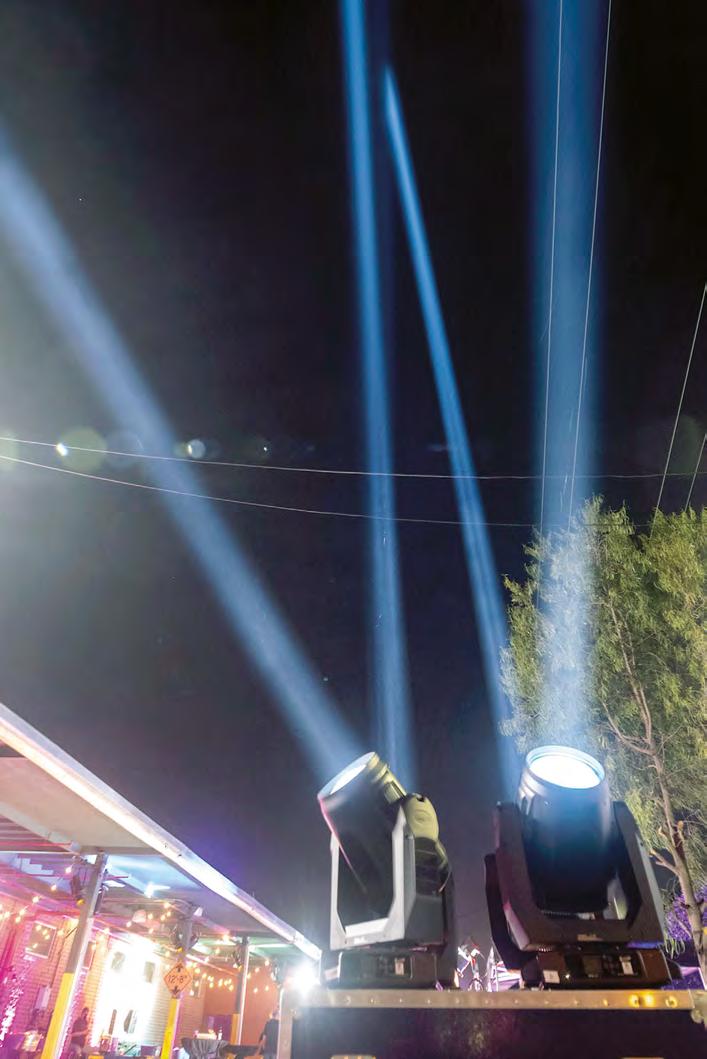
ELATION PROFESSIONAL
recreated the sky tracker effect using its existing Proteus Excalibur lighting rig with the introduction of its Sky Motion searchlight mode. The mode is built into Proteus Excalibur’s latest firmware and is accessible via a dedicated menu display.
Sky Motion comes with a variety of preset movement designs and patterns which can be customised directly in the fixture. IDs can be assigned to set up a variety of searchlight patterns and can be adjusted for size, speed and colour directly from the fixture display. With 7,500 lux at a distance of 100m, the company claims the Proteus Excalibur is comparable in output to large 2,000W or 4,000W Xenon systems and operates at a fraction of the power. The low power draw means that no generator is required.
The unit houses a 550W Flex discharge lamp and projects an ultranarrow 0.8° beam from a 260mm front lens to create the searchlight effect. Fully IP65-rated, the compact fixture stays operational in all weather conditions and only requires

IP65-rated five-pin DMX cables and power.
Elation reports the Excalibur fixtures are easy to set up without a DMX lighting controller and, because
the system is autonomous and standalone, there is no need to transfer data or set up a control
ETC builds on ColorSource family
ETC HAS unveiled a trio of multivenue fixtures. The ColorSource V series includes ColorSource Spot V, ColorSource Fresnel V and ColorSource Spot VXT. All three use a five-colour array of red, green, blue, indigo and lime, which the company reports produces softer pastels and bolder colours from
the same fixture. In addition, the fixtures include wireless DMX/RDM and NFC for remote configuration, and the manufacturer has increased brightness over previous ColorSource models while using the same lens tubes, barrels and accessories as ETC’s other spot fixtures. The Fresnel V incorporates
strobes and chasers.
www.cameolight.com
not familiar with lighting and DMX can prepare and run the Sky Motion system.
In other news, the Fuze Wash 500 is a full-spectrum LED Fresnel moving head fixture designed for a wide array of precision lighting applications. It houses a 500W RGBMA LED engine and delivers 17,000 lumens with a CRI of 92. It is designed for any application where an automated Fresnel fixture with impactful colours, a wide zoom range and a soft field of light are required.

The Fuze Pendant Compact is an energy-efficient downlight that can reportedly adapt to any environment and is small enough to fit into a variety of spaces. Housing a fullspectrum 144W RGBWL LED array, the manufacturer reports it produces beautiful colours as well as high CRI variable white tones. Colour temperature adjustment is from 2,400–8,500K. Convection cooled for silent operation, a variety of mounting options and lens choices allow for precise light distribution.
www.elationlighting.com
a true microFresnel lens and motorised 14–46° zoom control from both the back of the fixture or a control channel on a console, while the IP65-rated Spot VXT has been designed for
www.etcconnect.com
56 WORSHIP AVL March–April 2023 PRODUCTS
Proteus Excalibur Sky Motion
ColorSource Spot V
P2 FC
ADJ Jolts forwards with lime LED technology
DESIGNED FOR concert productions, rental houses and permanent installations, the Jolt Panel FX and Jolt Bar FX fixtures combine bright strobe LEDs and zone-controlled, colour-mixing LEDs for generating a wide variety of effects. The Jolt Bar FX is a linear
RuntimeExtender provides emergency power for Astera
total of 800 0.3W RGB SMD LEDs. Weighing 6kg, the fixture is equipped with a single variable angle yoke which locks into place securely using two plastic handles. Both units offer strobe speeds variable between 0.35Hz and 25Hz, as well as multiple effects options, including ramp up, ramp down, ramp up-down and random, in addition to regular constant strobing. A wide variety of vibrant colour options can be achieved using the RGB LEDs through individual dimming control of the independent red, green and blue elements.
Supporting eight and 11 options respectively, the Jolt
ASTERA’S RUNTIMEEXTENDER is a battery plate for lighting techs working with Astera products to allow connectivity to an external battery. This means that spare camera batteries can power Astera units if the internal batteries run out. It is compatible with most Astera products, including Titan, Helios and Hyperion Tubes, HydraPanel and PixelBrick. When connected lights are running at low level or switched off, the internal battery recharges from this connection, allowing batteries to be swapped during the shoot with no loss of light.
To match the most common kind of camera battery, RuntimeExtender is available with V-Mount and Gold Mount connections, and supports both 14.4V and 26V battery types.
a central strip of 112 5W cool white SMD LEDs, surrounded on both sides by a total of 672 0.3W RGB colour-mixing SMD LEDs. Both types of LED are grouped into independently controllable zones for generating strobe chases and coloured animated pattern effects. Weighing 4kg, the 1m-high fixture measures 104mm x 111mm and features two 180° variable angle brackets.
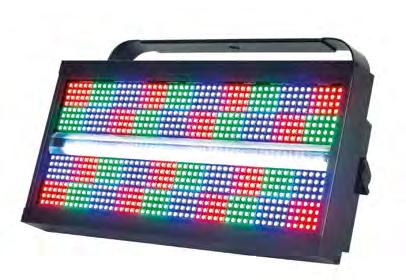

Measuring 159.5mm x 405mm x 250.5mm (LxWxH), the Jolt Panel FX is a complementary panel LED lighting fixture that incorporates 48 5W cool white SMD LEDs, surrounded on both sides by a
levels of zone control, ranging from the separation of white and RGB LEDs up to full independent colour mixing and dimming control for each zone. Nine white macro patterns and 25 colour macro patterns can be selected remotely via DMX and provide ease of programming. Located on either side of the back panel are the five-pin DMX input and output sockets plus a USB port. A backlit LCD display on the rear of the unit, with four touch buttons, promotes DMX addressing and mode selection through a menu interface.
www.adj.com
Any Watt/hour (Wh) capacity battery works with Astera fixtures, including units just below 100Wh which can be checked into an airplane hold. Batteries can be connected via an existing Astera power/data cable or via a 1.5m cable included in the kit.
All of Astera’s VDC lights are supported and RuntimeExtender is rated to 24V 100W shared between two DC outputs. While in the event world, the three-pin XLR is universally used for data distribution, in the film industry it has become a standard to distribute power. Therefore, a third three-pin XLR socket has an unregulated output that passes on the voltage of the battery. This also means it can be used with
Be still with Robe’s TX1 PosiProfile
DESIGNED TO operate both as a moving head and as a static profile, Robe’s TX1 PosiProfile luminaire is intended for use in confined spaces where access or movement options are limited. Fixtures usually require pre-use pan and tilt movement calibration to ensure accurate control when power cycling. The TX1 PosiProfile uses Robe’s Motionless Absolute Positioning System (MAPS)

to ensure the fixture stays motionless while calibrating. The company claims this is what makes it ideal for tight spaces. In addition, Robe’s Brake Attribute Retention System (BARS) means that motorised attributes like pan and tilt, zoom and focus remain locked in place until being released. The TX1’s MSL-TE 500W Multi-Spectral LED engine generates over 13,500 lumens.
future Astera products which may use a different voltage.
RuntimeExtender is also available as part of a kit which contains four RuntimeExtenders, HexConnectors, BrickConnects and 1.5m DC cables, plus four clamps to mount with the Astera’s HexConnect. Two kit versions are available with V-Mount or Gold Mount connectivity.
www.astera-led.com
The lighting manufacturer has also expanded its iFORTE range of LED lights with the iFORTE FS. Designed for precision follow spotting applications in outdoor environments, the iFORTE FS comes with an integrated IP65-rated camera for weatherresistant remote outdoor follow spotting.
www.robe.cz

March–April 2023 WORSHIP AVL 57 PRODUCTS
TX1 PosiProfile
Jolt Bar FX
Jolt Panel FX
Keeping it simple
FLIPSIDE
SOUND SYSTEM
WAS founded in 2013 by James Cooper and Mikey Layton, designing and building loudspeaker systems specifically for nightclubs. After a few years heading down this path, the company started doing rentals and more installations and, as a result, decided to change its name to Flipside AV and launch a new website in 2022. “Flipside Sound System didn’t really represent what we did any more,” explains Cooper. “We’re not really just a sound system company – we do a lot more than just audio; today, we do more AV and streaming systems, and that changed the type of jobs we were taking on.”
Prior to the new website, the company had begun actively seeking out HOW installations by investing some money on search engine optimisation
(SEO). “Luckily, eight times out of 10, if someone is looking for an AV upgrade for their church, they will write ‘church AV system’ or ‘church sound system’ into Google, but with other AV installations the wording people use in Google can be more vague, so we found the church sector quite easy to penetrate.”

Slowly, Flipside AV’s HOW projects started to grow. Initially, the company adopted a far more personal approach, which converted well to smaller jobs, but it wasn’t working so well for the higher paid jobs that it was striving for. “So, we shifted the company’s marketing approach and the worship installations have developed from that, so we now tend to work on fewer jobs but they have a higher value. We’ve been mostly installationbased for about six years now.”
Cooper believes the only difference between church AV systems and other sectors is the way the system is used. “We went into the church AV sector without thinking that the installations were going to be special or different in any way,” he adds. “I’ll go into a church meeting and choose equipment that is best for the job, rather than other companies who might propose equipment that has worked well in other church installations, and I think we did quite well initially using this approach. I’m more interested in designing a system that works for each individual client. No one, for example, was really using Yamaha in churches four or five years ago but it’s an ideal system and now it’s commonplace.”

Today, the company’s turnover is about 40–50% church
probably equate to 20–30% but, in the last couple of years, we’ve had more high-ticket jobs that have boosted this to 40–50%.” But would Cooper change this balance? “I like designing systems that solve problems for people and that they find easy to use. I like eloquent solutions to problems and delivering them in a worship environment is really good for that and it’s really satisfying to do. Plus, the people we deal with are friendly and the buildings are pleasant to work in. I used to enjoy designing speakers but now I enjoy designing entire systems that incorporate cameras, streaming, sound and networking and working out how the whole ecosystem can work reliably and coherently, and also efficiently. But the environment doesn’t matter. I like the variety. We’ve done offices in Farringdon with meetings rooms, event spaces, a fibre-optic network linking 15 cameras and NDI networking, then I’ll be in a church the next day and then a restaurant and then a theatre. It keeps things interesting.”
But what Cooper really likes about churches is who’s using the equipment. “I will always design a church system around the fact that there won’t be just one person who will be operating it. Everything needs to be extremely user-friendly. Even if you’ve got a church with a large system, I want it to work so that anyone can come in, turn it on, hit a couple of buttons and that’s it. And I want to be able to walk away at the end of the job and not hear from the customer again. That’s what sets churches apart and that’s what I enjoy designing.”
www.flipsideav.co.uk
58 WORSHIP AVL March–April 2023 THE TECH VIEW
James Cooper
Flipside AV MD James Cooper discusses his approaches to HOW installations and the similarities with the company’s other AV business
Flipside AV recently equipped Ashington Parish Church

LA7.16 i
AMPLIFY DIFFERENTLY
Think differently about how amplifiers should work: Explicitly designed for installation environments, LA7.16i is a multitasker with 16 output channels, each able to produce 1300w at 8 ohms.
Multi-Channel, Multi-Type, Multi-Time, Multi-Signal.





 The Evolution Wireless Digital Series
The Evolution Wireless Digital Series
















































































































 31.1 - 3.2.2023 Barcelona - ES Fira Barcelona Gran Via Booth 5E400
Professional Studio Event Technology
Signal transmission hardware (HDMI®, HDBaseT, etc.)
Bulk cables according to EU CPR, RoHS
31.1 - 3.2.2023 Barcelona - ES Fira Barcelona Gran Via Booth 5E400
Professional Studio Event Technology
Signal transmission hardware (HDMI®, HDBaseT, etc.)
Bulk cables according to EU CPR, RoHS




 Photo: Tanner VonnahmeI, unsplash
Photo: Tanner VonnahmeI, unsplash































































































































































